#none of the characters are likable or well rounded
Explore tagged Tumblr posts
Text
Bro house of the dragon is the most boring show ever created why was it so hyped 💀
#take away the dragons and the medieval setting and its just a terribly slow paced family soap opera with god awful dialogue#none of the characters are likable or well rounded#literally on episode 10 right now and i still don’t find it in me to care about any of the characters or the plotline#are they (hbo) not embarrassed??#edit: why are there so many traumatic birthing scenes??? like every other episode?? stop doing that
0 notes
Text
There are so many pivotal elements that go into nailing a successful show, and one of those is having likable characters. Luckily, NCIS: Origins has plenty to work with in Mike Franks.
Don’t get me wrong, because I am the unofficial leader of the “Mary Jo Fan Club,” but Mike Franks is something else.

The character has been a staple of the franchise’s flagship series, NCIS, since its inception. So, his presence in a prequel series was heavily expected and very much appreciated.
However, there’s no way anyone could have known the amount of talent Schmid would bring to the character, let alone the unexpected, well, sex appeal.
There’s A Lot Under Mike Frank’s Rough Exterior, But You’d Have To Get Past The Chiseled Abs First

I’ll be the first to admit that there is something very attractive about the younger Mike Franks. While that partly has to do with the actor’s natural good looks, it goes far beyond that.
For one thing, Mike’s presence is felt in almost every scene, whether he is present or not. I’ve said in most of my reviews for NCIS: Origins that Mike is a big part of the heart of the show.
He cares deeply for the people in his life, whether they are personal or professional relationships. Although, with Mike, there is a big overlap between his home and work life.
How else could we have gotten a scene of Diany Rodriguez’s (The Blacklist) Vera rousing Mike from a hangover coma with nothing but his tighty-whities on? Mike’s abs did a lot of the heavy lifting after that.
His chiseled midsection, coupled with his devotion to Tish, makes for marriage material if I’ve ever seen it.
Everyone Loves A Well-Developed Character, And Mike Might Be The Most Complex Character on NCIS: Origins

Honestly, the most attractive aspect of Mike Franks is that he always seems ready to put someone else’s issues before his own – even if it puts him in an uncomfortable situation.
He may not be the best with his words, as poor Special Agent Lala Dominguez has experienced on more than one occasion. In the end, though, he always makes good with the people he cares about.
Even though Austin Stowell‘s Gibbs is the protagonist and the root of the main plot points, a lot of time it really feels like this is the “Mike Franks Show.”
Then again, it’s safe to say, at this point, that he is the most well-developed and complex character on the series so far.
Mike Franks isn’t just for the ladies either, because Mike is man’s man through and through, with the cowboy vibes and boots to boot.
Mike’s Perfectly Imperfect Personality Makes Him The Most Relatable Character On NCIS: Origins So Far

Now, I have never found “crumb catchers” particularly enticing, but damn it if that man doesn’t know how to rock a stache. They haven’t shown it yet, but I bet Mike gently brushes his mustache every night before bed.
With his grizzled demeanor that is as subtle as a shotgun, it would be so easy for the character to rub any viewer the wrong way, but it works.
That is, in no small part, due to the almost three decades that Kyle Schmid has spent in the entertainment industry. From Accused, SIX, and The Rookie, Schmid has made the television rounds.
However, none of his roles have ever put him through a transformation like the one for Mike Franks. So, what exactly does Kyle Schmid do to make Mike Franks so sexy?
First off, there are too many variables for it to be just one thing. Kyle’s good looks and talent, coupled with the established history of Mike Franks, is exactly how you craft a fan-favorite character.

He sees the faults in others but easily looks past them because he is fully aware of the faults within himself.
Suffice it to say, CBS‘s NCIS: Origins knocked it out of the park when they picked Kyle Schmid for Mike Franks.
8 notes
·
View notes
Text
So, when I get really into a new show, I like to go ahead and look up the meaning of character’s names. Often there’s not much of interest there, or the name doesn’t say a whole lot. Then, every once in a while, I come across some neat stuff, which is what happens when you look into the meaning of names for A League of Their Own characters, particularly Greta and Meg's names.
The first very first thing I found when I started down this specific rabbit hole is that Greta means “pearl,” which honestly makes so much sense for her. A pearl is this pretty, shiny object, but it's created when a grain of sand or food particle gets stuck inside the shell of the oyster. To protect itself from the irritant, the oyster secretes a substance that will harden around the grain of sand and eventually become the pearl. Greta is exactly like the pearl in a lot of ways, because she’s shiny and charming, but her outward appearance is very much a product of all the things she does to protect herself from getting hurt. She has this secret that she knows is dangerous, and she constantly cloaks herself in this protective layer, putting on a performance to keep herself and those around her safe. The product is pretty to look at, made to be looked at even, but it is a hard outer shell meant to protect Greta from suffering any more pain than she already has.
In an interesting twist, Meg means “pearl” as well, because both names appear to have roots that can be linked back to the name Margaret. We know so little about Meg, Carson’s sister, that any attempt to draw parallels requires a certain amount of speculation. If the parallel is meant to be intentional though, it would suggest that there’s something similar about Carson’s sister and Greta that we don’t explicitly see.
One possibility is that perhaps Meg’s fixation on behaving acceptably in the eyes of those around her comes from the fact that she thinks it will offer a layer of protection from censure. That’s why she marries and has kids right away, and bakes the pie that Carson promises the woman at the train station to save face (Greta’s end of the phone conversation with Meg suggests as much). That behavior and her insistence that Carson conform is a defense mechanism, a hurtful, damaging, deeply misguided attempt to protect herself and her family from the same sort of pain that comes from their mother failing to conform when she leaves them behind. She might actually be more concerned about protecting the family than herself, as she specifically mentions their father having to answer questions, as he probably had to when their mother left. She even says she wishes their mother was around so Carson wasn’t her problem, which suggests that Meg wouldn’t be reacting in this way if their mother had never left. Is Meg simply suggesting that their mother might’ve made this call instead? Maybe, but the fact remains that Meg behaves in the way she does, calls and yells at Carson for running away because their mother isn’t around, and she feels it’s her duty to do it to maintain an acceptable image of their family. It's a misguided attempt to protect them from censure and the same pain that comes from their mother leaving.
The natural reaction may be to say, well, Greta and Meg are nothing alike, because there are a lot of ways in which they’re not alike at all. To start, the repercussions of not performing properly are so much higher for Greta than Meg. Meg doesn’t face the threat of physical harm that Greta does, and the censure she faces is much less intense than what Greta faces if she’s discovered. The fact, however, remains that a lot of their behavior is a reaction to societal pressures to conform and an instinct to avoid pain. None of this is to say that Meg’s behavior is remotely acceptable, or that Meg could ever be as compelling and well-rounded as Greta. What we know of Meg isn’t even a little bit flattering, but I don’t think Meg has to be likable to be understood. This potential parallel simply gives a bit more depth to Meg, makes the story as a whole a bit more interesting. It suggests that every female character, even the ones as minor and unlikeable as Meg, face some kind of societal pressure to perform in a certain way or face repercussions, and their behavior and treatment of others is often shaped by that pressure.
Again, this all involves a certain amount of conjecture, and may very well be a coincidence, but ALOTO is such a thoughtful show that I just can’t help thinking there’s a real possibility this was an entirely intentional choice. Greta’s name meaning and the Meg parallel were the most compelling ones I found, but there’s also a whole bunch of other name meanings that I’ve found that are actually perfect for the characters, which suggests to me that at least some of these character names are very intentionally chosen for their meaning, and I could definitely see more meta potential in that list. Whether the name choices are fully intentional or not, I enjoy thinking about the way that small details contribute to a story’s larger, overarching themes, and love that this show continues to offer up opportunities to do just that.
#ALOTO#a league of their own#Greta Gill#meta#I hesitate to post this because I don't want anyone ever thinking I'm a Meg stan#I am emphatically NOT a Meg fan#I just enjoy finding connections and seeing how they might fit within the larger narrative#I'd also be open to other folks who might have some other theories on what the parallel might signify#talk meta to me#my stuff#this show has me in an absolute chokehold in the best possible way
27 notes
·
View notes
Text
Dont mind me just dumping my 2.5/5 star review of s1x of cr0w5 here because i need to get this off my chest 😭
I consider myself a very average person in the sense that i, more often than not, like what’s popular. Usually i agree with the majority and even when i don’t, i still see the appeal and just go, “ok, not for me.” But this book was terrible. I fail to see what people actually like about it…… and it’s not like i picked it up because of the rave reviews, my sister let me borrow it because she liked it. I didn’t check other ratings or reviews at all, so when i finally finished it (a feat in and of itself) and went to log it onto my goodreads, i was shocked by how much love it received lol. Yes i am 27 but i still do like YA, so that wasn’t the issue here
Starting with the good: i think b4rdug0 did decently with her prose and worldbuilding, settings and people were described well enough that i wasn’t TOO confused. That and w¥lan and j3sp3r’s banter were the only things i liked.
Getting it out of the way that although i would’ve preferred them to be aged up, it’s not really something i cared about much. A lot of the people who didn’t like the book complained about this, but other than them having too much experience for the years they have lived on this planet, i just shrugged it off because eh, it’s YA. Ofc there will be some sort of power fantasy involving teens.
For the plot, i was so excited for it because heists are fun and it’s amazing when the tension is set up right!!! Alas, everything was too conveniently resolved. Just as you think the tension can finally be built, the scene is over. Or something is happening omg, and then you’re hit with a flashback that completely takes you out of it. Don’t even know what the stakes were for this operation. It sucks how predictable a lot of the conflicts were :’) the appeal of a heist is when you don’t know what will happen, when you’re a hair’s breadth from getting caught but you don’t.. didn’t feel that at all here. It almost felt like they just waltzed in and out
The characters felt SO flat to me. Some of them felt like caricatures while the others were simply trying too hard to be edgy, and some felt like an afterthought (ahem, w¥lan). None of them are likable, which is fine i don’t need to like characters honestly, but unlikable to the point of me not being invested in them at all. I didn’t care what happened to any of them. Their relationships with each other don’t feel important enough, and then they’re all paired up… huh? I don’t care enough about nin4 x matth14s, the author didn’t care enough about j3sper x w¥lan. In3j and k4z would’ve been ok if the author set it up well enough. It would’ve been nicer if it were a bit more of a slow burn, perhaps their relationship picking up in the second book. WHY did she have to force it to happen in the first?????? It felt so out of character honestly, like you set up k4z that way and then you tell me he acts like this…… if there were moments prior wherein k4z would act contrary to how people thought he was then it would’ve been believable. But legitimately his behavior blindsided me lol.
Nin4 being plus sized could’ve been handled better too. Oh i like eating, i’m indecently round (LIKE WHAT IS THIS), my jugs are big. What in the world
The use of foreign language feels… kinda forced and clunky? I’m all for worldbuilding, and it’s great that there’s diversity in this fictional world, but the foreign languages aren’t used in any way that furthers the narrative. It’s jarring, like when someone is speaking in an american english accent and then says croissant as cwahsahn. D
Anyway i’m surprised i finished it. Had to skim the last 50 pages because i just wanted to see how it would end. Kinda expected the “twist” unfortunately. Also i cannot take anyone named p3kk4 r0llin5 seriously as a villain lmao
0 notes
Note
Season 11 reads like AK was strapped to the front fender of the car rather than driving the thing. I have been wondering about who's actually responsible for this season's mess ever since the beginning of B block since you don't go from resurrecting a show way past its prime (I can't emphasize enough how great a feat that is!) to not being able to construct a cohesive season arc. Sadly, AK has probably known since she changed her instagram that there would be no spinoff for her.
The little moments: Connie wanting to go w/ Carol, the lingering Caryl looks, Carol tending to Maggie's cheek—those feel like someone's desperately trying to add the actual story in the cracks of a crowded script. I don't want to make you all go TLDR; by giving a point-by-point as to why I think Gimple's providing the notes, but his John Hancock is all over this season. There's definitely studio intervention and it goes far back, to the start of the season.
S11 is very male-driven: it's about Daryl, Eugene, Hornsby, Aaron, Gabriel... We even have more Tomi than Yumiko. Even though there's Maggie (and Leah), we don't get any emotional depth to them, just like we didn't get enough of a red thread to Carol's emotional arc in S6 beyond MMB's nonverbal cues. We have more insight into Hornsby than Maggie. Alpha was well-rounded and Leah could have topped her for scariest villain, because her trajectory would have started out as 'likable' girlfriend.
It feels like there's no point to Pamela Milton; she's wallpaper and a waste of a good actress. There's none of that intricate emotional interplay between Milton and Hornsby that we got with Alpha and Beta. They were foils for Carol and Daryl, but we have no such parallel with Milton and Hornsby, which beggars the question, why? The setup is perfect but squandered, and we know this is something AK can do beautifully.
[I may have worked out how to submit a wall of text! :P – secret friend]
All really great observations. The weird framing of the story was definitely something I caught onto, though I attributed a lot of it to scrambling to tie up loose ends for supporting characters whose stories would be coming to an official close by the end of the season and having way too many supporting characters to do that for. Now that you mention it, I absolutely see how a lot of it is centered around men while there is no emotional realism for the women. Maggie being forced to trust Negan, Carol and Connie not checking in with each other, Carol and Leah not having a confrontation despite the big roles they’ve both played in Daryl’s life. Kang spoiled us in S10 and imagining what she could’ve delivered in S11 if she was really in the drivers seat is...sigh.
#caryl#caryl deserved better#carol peletier#carol peletier deserved better#melissa mcbride#melissa mcbride deserved better#angela kang#angela kang deserved better#darylneedscarol#lookattheflowersamc#weaintashescollective
52 notes
·
View notes
Text
Dragons: The nine realms season 3 review/thought
At first I'm considering formating this review as "The good, the bad and the ugly" But after having watching it I feels that there's too little for me to consider bad or ugly so instead this is going to be in the usual mix opinion bullet form. and my general opinion is that----
Season 3 is easily the best of the 3 season! and the closest it feels to the old series with how dragons focus it is. It's like an improve season 2 without dubious dragon designs like Bubblehorn or Spiderwing or a horrible Buzzsaw introduction episode. Of course there’re still problems and I wouldn’t say the improvement is drastic or series changing that would convinve people to like the show if they’ve already decide via first two season that the show is not their cup of tea. The plot and written is still bare-bone and only servicable but all in all It’s still the same turn your brain off dragons of the episode show I can enjoy with the open-minded. Now for the indepth points;
- There are 3 new named dragons introduced in this season and I'm very glad to say that for once, all three dragons hit and none has miss! I really love these new additions whole heartedly. Flamethrowers although I would place somewhere in the middle tier comfortably with something like Sandbuster, Grim gnasher or Shadow wing, you know, late rtte dragons (and has lame name) as like not having much to standout, I do think is one of the most, how should I say this, completed well rounded design from nine realms if I say so myself.

Deadly Spinner is weird but in the good endearing weird, my favourite kind of weird. I like my dragon weird and eff up. They are Therizinosaurus sort of weird animal. also Bias but they reminds me of my fan dragons. I also like the face and the spine. This is kind of thing I'm talk about with Spiderwing. Spiderwing basically just a spider with wings slapping on top of it but this guy is a properly spider inspired dragons the way I like. Still sad we dont get to see animated silkspanner though. Dreamworks come on!!!
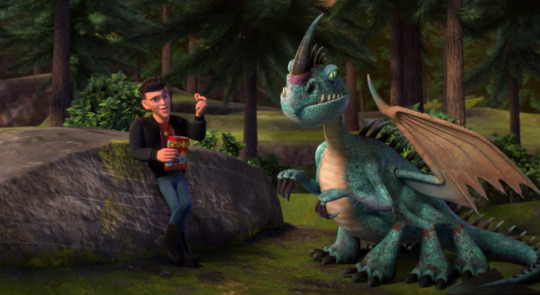
and lastly the Sky torcher is a thing of beauty! I was very surprise when the thing appear and looking this good thanks to the lack of appearance in the trailer or marketing, nice!
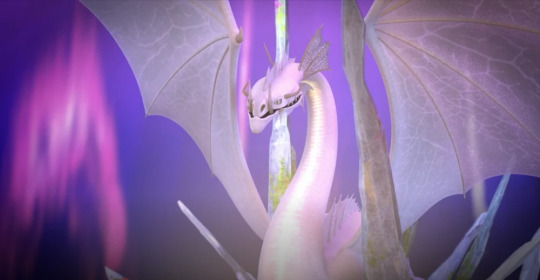
oh and also there are these nameless guys.

- All the returning species are a darling and was done justice and got a lot of screentime for their whole episode they appear. There're monsterous nightmare, Gronckle (fire gronckle but basically the same thing),Fireworm, Quaken and Hobgobbler who make a debut in any series ever. as well as Terrible terror and Razorwhip who are still here to stay. Fireworm is my one of my top favourite and seeing them get the episode dedicate to it make me happy.
Although why is nightmare walk like the nadder? When is fireworm having pupils?
- I have mentioned this before but I like that they avoid mentioning the old dragon species name because it would make no sense for the kid to come up with the exact same species of dragons, with the closest mention of it being "These little terrors" or "this fire breathing Nightmare". Monsterous Nightmare is more or less being dub as "Fire breather" in this era. (kids and their creative naming smh, it fits the kids character but hahaha)
- Feather and Alex are continue to cary the show. Not just for their likability but also their in-universe compitent like omg Feather make Thunder look so incompitent with all the heavy lifting she pull this season, Night fury who? she basically naping the MVP status none stop. Big bad dragon? disorientrd with her scream. Human discovering dragons? invisibility. Needing distraction or prep talk? Alex got your back. I think at this point Feather is now my third favourite dragon character after Thornado and Cloudjumper

-There're clear progression of the human discovering dragons plot, something I normally dread on the previous first two season for being the bad part of the show but this season they actually handle it pretty well because like i said, clear progression (instead of keep dancing around it). Eugene now knows. Alex moms now sorta know. Buzzsaw now knows...
- Speaking of Buzzsaw, he's still the negative spot of the show and is a very incompetent villain but looking at him as a Diet Dagur and it made sense and somewhat passable. Still pretty weak and annoying and yeah.."Diet"
- As for the scient site stuff, they're actually mostly on the side line this season and not much of a bother.
- Eugene! I like his inclusion in this season and the team!
- Jun's character is actually improving, a welcoming improvement
- There's a lot of good human-dragon interaction in this season. Particulary on the first episode between Tom and the Monsterous Nightmare, The quaken episode and the last episode with Tom and the Fault ripper arc being resolve. The quaken episdoe while i still has some issues on the ending think handle an interesting set up of D'angelo just---just---feeding Quaken's eggs to the gronckles and deal with the grieving mother. The ending is kind of a cop-out but it's still the episode I enjoy
-Majority of the jokes actually land and I found myself chuckling on various point in every episode. I plan on putting it in the review but found there's so much so I just going to bring up one of my favourite being when Buzzsaw discovered Thunder and Eugene just yoink him in the heas and put a leaf on him.
-Thunder takes a back seat????? which might consider be a problem/issue to thunder continuing to be the boring one (tm) of the show but because I have that issue with thunder the fact that this season barely focus on him actually kind of feel nice. Like he's still around but kinda being just as Tom's riden dragon. Almost similar to how Toothless in the old series doesn't have much character outside of Hiccup riden dragon either *gunshot*
- The invasive species plot in this arc make me think back about the ethnicity of Toothless' decision in Hidden world and reminds me of my own plot------pro-segregation Toothless/hj
- Sad theres nothing to come out more of the Alpha gem yet. It's one of the plot thread I'm very interesting on (again because it reminds me of my own plot)
- The musics while over-dramatic at time, do slap
- better texture and lighting? I think composition and animation still the main issue that is work against it but season 3 look much better on the eye or I might just already getting use to it.
- The ending. I'm never that BIGGGG on rtte either but I gasped and getting a little giddy.
- I 90% predict snow wraith is going to show up next season (because we know they're going to be in the game) also finger cross for desert realm desert realm desert realm
Over all pretty happy/content with this season and actually very excited for the next one. again, if you are not on board in the first place this probably still wont do it. but I'm happy. I will also be looking forward to the video game that is going to be release later this year.
Lastly, the regular new dragons rank. I will do both what I think is the best design and what dragon I feel emotionally attach to this time. There're some old dragons that move up and down on rank though to my opinion changing on them due to exposure, like Misttwister who is growing on me quite a bit. Magma breather is straight up just a good dragon with good design I took back my lukewarm opinion from the last season. Fault ripper I still have problem with how it looks generic and out of place and like melificent dragon stumbling into the wrong show but I can begin to acknowledge the merit of some of its design and I don't turn my nose when I saw it again this season. I actually like it fine. Flood fang unfortunately droping down due to lesser exposure and me begin to think it's too simple.
Best design <> Fav dragons
1. Gembreaker, Featherhide
2. Featherhide , Gembreaker
3. Flamethrower, Deadly Spinner
4. Sky torcher, Sky torcher
5. Magma breather, Magma breather
6. Flood fang, Flood fang
7. Deadly Spinner, Flamethrower
8. Misttwister, Misttwister
9. Faultripper, Faultripper
10. Thunder, Thunder
11. Spiderwing, Spiderwing
12. Bubblehorn, Bubblehorn
#httyd#httyd the nine realms#httyd: the nine realms#httyd nine realms#dragons the nine realms#dragons: the nine realms#the nine realms#nine realms#the nine realms spoilers#tnr spoilers#dtnr spoilers#tnr#dtnr
5 notes
·
View notes
Text
Persona Lite with Fire Emblem sprinkles on top
I’ve been addicted to Tokyo Mirage Sessions #FE Encore on my Switch for the past few weeks, and I’m getting close to wrapping it up. I figured it’s high time I talked about it a bit.
The game that would become Tokyo Mirage Sessions (TMS) was first announced as “Shin Megami Tensei x Fire Emblem,” which is absolutely not a good way to describe what this became.

This title led so many people astray.
What comes to mind when you think of (mainline) Shin Megami Tensei games? An apocalyptic or post-apocalyptic setting. First-person-perspective battles. Negotiating with demons. Battles against deities. TMS contains a little bit of the third thing on that list, and none of the others.
What comes to mind when you think of Fire Emblem? Medieval-era settings. Permadeath (either optional or mandatory). RTS-style combat. The famed “weapon triangle.” Support conversations. TMS contains the fourth thing on that list, and none of the others.
But let’s be honest here: For most people (especially Westerners), the first thing you think of when you think about Shin Megami Tensei isn’t even the games with “Shin Megami Tensei” in the title. It’s the Persona series! They’ve grown far more popular than their parent franchise at this point.
So I suppose it was natural that TMS is, at its core, a “Persona Lite” game. The darker edges of Persona titles are removed in favor of something more T-friendly, but the basics are all there: A group of teenagers in modern-day Japan discover a strange alternate dimension that they can access which also gives them the ability to summon supernatural powers/entities. When people start to go missing in this other dimension, it falls to this group of teens to unite and save the day, ultimately leading to them discovering the reason why this alternate world has been bleeding into modern Japan in the first place and, in the end, saving humanity from annihilation. That’s totally how Persona works, and it’s also totally how Tokyo Mirage Sessions works!
However, instead of summoning Shin Megami Tensei demons as “Personas,” the heroes of TMS summon Fire Emblem characters that are “Mirages.” Each character is permanently linked to a single Mirage, so there are no “Wild Card” characters here. However, you can level the characters’ mirages up to make them take on new forms and new abilities. FE fans will notice that all of the characters here are from the Falchion/Tiki/Shadow Dragon stories - the two Marth adventures (Shadow Dragon/Mystery of the Emblem) and the semi-recent 3DS hit Awakening.
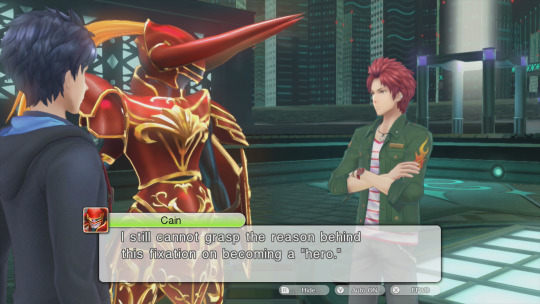
For some weird reason, all of the Fire Emblem “mirages” wear helmets, masks, or other face coverings 100% of the time. The only exception is Tiki.
The lack of the darker themes in many Persona games and the fact that there’s no “Wild Card” to manage is what makes this, in my opinion, more like PERSONA LITE. And then you get your Fire Emblem backup characters to serve as extra flavoring. The characters we meet from Fire Emblem are rarely the focus — you spend most of your time with the teen heroes — but they still manage to show off their unique personalities and carry in a load of FE fanservice. (The good kind of fanservice where it’s full of references and nods to the continuity of the series, I mean. Not the other kind where it’s softcore porn.)
Fire Emblem fanservice was one of the biggest delights for me here. If you’re looking for any SMT/Persona characters to pop up and link the continuity together, you can stop looking because they aren’t here. But if you want to see specific characters from the three source FE games pop up here, a metric ton manage to do so. For example: Tharja (from Awakening) creates two golems for training purposes, which she names Bord and Cord after the pair of heroes from Marth’s era. And then the actual spirits of Bord and Cord possess those golems. So naturally, they start bickering and fighting. It’s delightful.
So yeah, there’s plenty of nods for FE fans to appreciate even if your favorite characters are taking a back seat to a bunch of teenagers. Fire Emblem fans will recognize the heroic mirages, the enemy boss mirages, the weapon triangle weakness/strength system and lots of musical cues. On the flip side, Persona fans will recognize the story structure, the magic spells the characters wield (things like “Mazio” and “Diarama” and “Rakukaja”), the common enemies you encounter and cameos from a few of the more famous demons found on signage around Tokyo. Sadly, there are no familiar sounds or music pieces borrowed from SMT/Persona that I noticed.
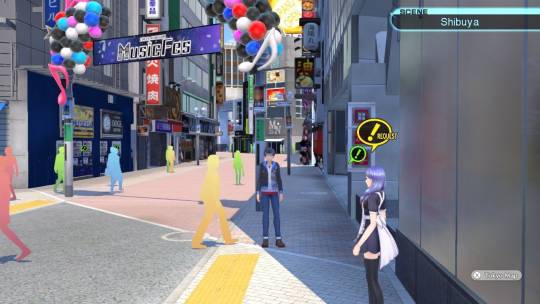
In addition to the main story, there are also “Side Stories” for your party and side quests from various NPCs. The whole game lasts around 50 hours even if you aren’t trying to 100% it.
And while the music here is mostly pretty good — especially the Fire Emblem themes — I really wish we’d gotten some Persona-style tunes in here. Persona soundtracks are absolutely killer and everybody knows it. I wanted to hear some Shihoko Hirata, some Lotus Juice, some Yumi Kawamura, some Lyn Inaizumi. Alas, that never happens. Sad face.
In fact, as far as vocal tracks go, you’ll only be hearing the performances of the main characters. See, the story this time revolves around a group of teens who are hired by a talent agency to become young starlets of the stage and screen. You meet plenty of pop idols, a cooking show host, aspiring actors, and those who do combinations of the above. There’s a lot of focus on the Japanese entertainment industry, and it’s mostly a very positive portrayal about how hard teen stars work to reach their dreams and how fulfilling it can be when they express themselves through their artistic pursuits. Speaking as someone who legitimately does not care one iota about the idol industry in Japan or Asia as a whole, I’m very happy that these characters managed to remain likable and their pursuits stayed enjoyable throughout. No one here is an ultra-deep character, but no one here is a total cipher, either. I’m additionally thankful that the vocal songs are another highlight of the soundtrack alongside the FE tunes.
The last thing I’ll bring up is the “Sessions” mentioned in the title. It’s a battle mechanic wherein striking an enemy with a weapon or element they’re weak to will enable other characters to start jumping in with follow-up attacks. At first, it’s just one or two follow-ups, but by the game’s end, you might be sitting there for 15 or more consecutive strikes on an enemy after you initiate a “Session” of follow-ups. The greatest quality-of-life improvement built into this Switch port is that you can turn on “Quick Session” to make these attack animations much shorter and more rapid than they ever were in the Wii U original. I never had to play that one, but I can’t imagine I’d have much patience for constantly triggering 15 attack animations with every round. SO glad I don’t have to sit through that.

This is just a two-strike Sessions, so it won’t last long enough for you to take a beverage break.
So yeah, there’s a lot for RPG fans, Persona fans, and most of all, Fire Emblem fans to dig in “Tokyo Mirage Sessions.” And since we already covered that Danganronpa fans are apparently predisposed to enjoying Persona and Fire Emblem, that probably means that YOU, dear reader, are likely to dig this game as well.
#tokyo mirage sessions#tokyo mirage sessions fe#tokyo mirage sessions fe encore#persona#fire emblem#video games#video game reviews
40 notes
·
View notes
Text
The Dos and Don’ts of Writing Smart Characters
Since I started this blog, one of the most common questions I’ve received has to do with the portrayal of intelligent characters. This is also one of the most difficult to answer -- excluding questions about characters with specialized knowledge sets, which are fairly easy to answer with source compilations. Most of the questions have to do with: how do you portray a smart character believably? How do you make the audience relate to them? Can I still make them likable? How do I avoid the pitfalls of popular media?
Well, I’m finally here to answer, utilizing examples from some of my favorite (and occasionally, not-so-favorite) media. Let’s jump in to the dos and don’ts of smart characters!

1. Do let the audience follow the character’s thought process.
As demonstrated by: Tommy Shelby from Peaky Blinders
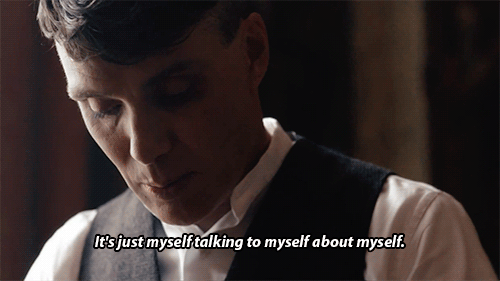
Albert Einstein allegedly once said, “If you can’t explain it to a five-year-old, you don’t truly understand it.” And the sentiment rings true: true genius doesn’t need to dazzle with big words and technobabble. Instead, it makes the complex appear simple.
The same rings true for brilliant characters. BBC’s Sherlock (more on that later) ceased to satisfy in its later seasons because it began to rely too heavily on visual glitz to avoid actually explaining its mysteries and how they were solved. Similarly, the biggest complaints with block buster franchises -- Star Wars, The Avengers, Game of Thrones -- is that they became obsessed with “subverting expectations” cleverly instead of leading the audiences to their most logical and satisfying conclusions.
Meanwhile, the smartest and most satisfying media dazzles not by staying over the audience’s head, but by illustrating how simplistic the solutions can be.
Let’s start with my boy Tommy Shelby, the charismatic, swaggering protagonist of the charismatic, swaggering crime drama Peaky Blinders. Using only his intelligence (and complete disregard for his own life/suicidal tendencies, but that’s not the point here), Tommy claws his way up from the near-bottom of the social ladder (an impoverished Romani in early 20th century Birmingham) to being a decorated war hero, to being the leader of a feared razor gang, to dominating the race track business, to becoming a business mogul, to becoming a member of parliament and trying to assassinate the leader of the fascist party. He’s also one of the paramount reasons why I’m bisexual.
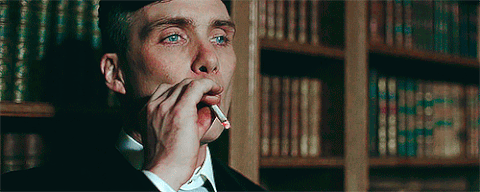
So how can such a drastic social climb be conveyed believably? Because Tommy -- as the viewpoint character -- is placed in seemingly inescapable situations, and then proceeds to demonstrate that the solutions to those situations have been there the whole time. I recently watched a brilliant video on how this is done, which can be viewed here.
Early in season one, for example, he responds to aggressive new methods by the police by organizing a mass-burning of paintings of the king, and uses the press this garners to publicly shame the methods of the chief inspector who’s been antagonizing him. In the next season, he talks his way into a deal by bluffing that he planted a grenade in his rival’s distillery. My personal favorite is in season four, when he responds to being outgunned by a larger, American gang by contacting their rival -- none other than an Alphonse Capone.
All of Tommy’s victories are satisfying, because they don’t come out of nowhere -- we have access to the same information he does, each victory is carefully foreshadowed, and we are reminded at every turn that failure is a very real possibility (more on that later.) So when he wins, we’re cheering with him.
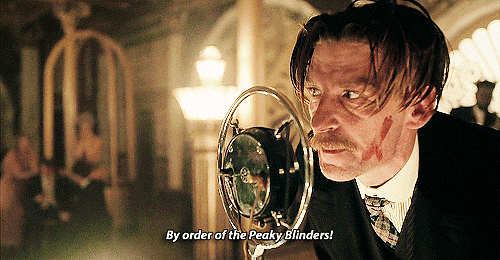
Other examples: Mark Watney from The Martian, who explains science in its most simplistic terms and with infectious enthusiasm. He would make every character on The Big Bang Theory cry.
Also, Miss Fisher from the AMAZING Miss Fisher’s Murder Mysteries. The dazzling, 1920s, female Sherlock Holmes of your dreams. I cannot recommend it enough.
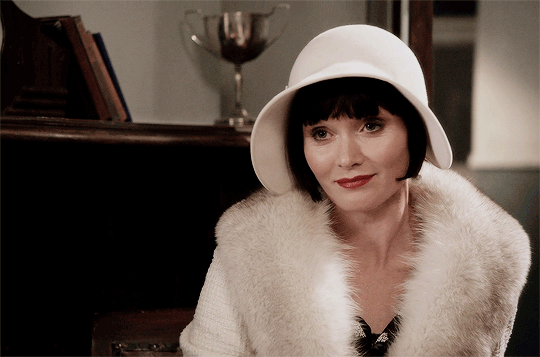
To apply this to your own writing: Remember you won’t dazzle anyone if you smack them in the face with a “brilliant” plot twist. They want to take a journey with your character, not be left in the dust.
Also, for everyone in my askbox concerned that they’re not smart enough to write intelligent characters, just remember how simple the problems confronting smart characters can be. Put them in a difficult situation, and provide them with a means of getting out. Then, just let them find it.
2. Don’t assume the audience is too stupid to keep up (or try to make them feel too stupid to keep up.)
As demonstrated by: Sherlock Holmes from BBC’s Sherlock.
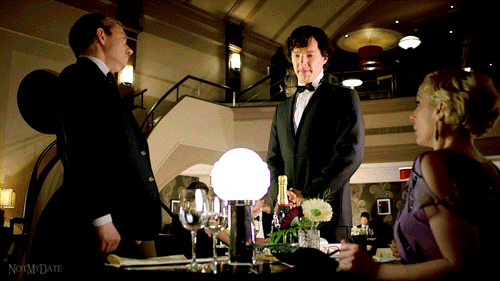
Say what you will: there were reasons why everyone was so captivated by this show during its first two seasons. It felt fresh. People had yet to become frustrated with the inescapable thirst for Benedict Cumberbatch. The writing was sharp, and the editing clever. And it wove a tantalizing web of mysteries that demanded solution. The problem was, there weren’t any.
The most frustrating for many was how Sherlock faked his death at the end of season two, after which devoted fans spent two years creating intricate theories on how he might have pulled this off. The creators responded by mocking this dedication in the opening episode of season three, by showing a fan club spinning outlandish theories (one of which included Sherlock and Moriarty kissing.) This might have been laughed off -- at the time, many seemed to consider it quite funny -- if the creators had bothered to offer their own explanation of how Sherlock survived. They didn’t. And so began a seemingly endless loop of huge cliffhangers that promised -- and consistently failed to deliver -- satisfying answers.
The most egregious examples occur in season four, which provided answers to questions no one asked, and withheld answers for things everyone wanted to know. For example, did you know that the real reason Moriarty engaged Sherlock is because he was hypnotized by Sherlock’s secret evil sister? The same one who killed Sherlock’s best friend, whom Sherlock convinced himself was a dog? Yes, that was a real plot point, in the climax of the series. It’s an effort to befuddle the audience with brilliant and unexpected writing, but instead pulled them out of a story they were already invested in and made them far more critical of its pre-existing faults.
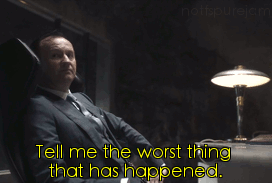
It’s pointed out in the brilliant (if bluntly named) Sherlock Is Garbage, And Here’s Why that Moffat can be a great writer, but is a consistently terrible show runner, because he’s more interested in dazzling the audience with cleverness than actually telling a satisfying story. The video also points out that the show often implied Sherlock’s brilliance, without ever letting the audience follow along with his actions or thought-process in a way that DEMONSTRATED his brilliance.
I highly recommend giving the aforementioned video a watch, because it is not only a great explanation of how Sherlock Holmes can be best utilized, but about how writing itself can be best utilized.
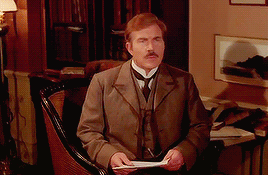
Other examples: The Big Bang Theory. As Wisecrack points out in their wonderful video on the subject, the punchline of every joke is “oh look, these characters are smart nerds!” which is repetitious at best and downright insulting at worst.
How to avoid this in your writing: Treat the audience as your equal.�� You’re not trying to bedazzle them, you’re trying to take them on a journey with you. Let them be delighted when you are. Don’t constantly try to mislead them or hold intelligence over their head, and they will love you for it. Also, cheap tricks do not yield a satisfying story: readers will know when you went into a narrative without a plan, and they won’t appreciate it.
3. Do remember that smart people can be kind and optimistic!
As demonstrated by: Shuri from Black Panther.
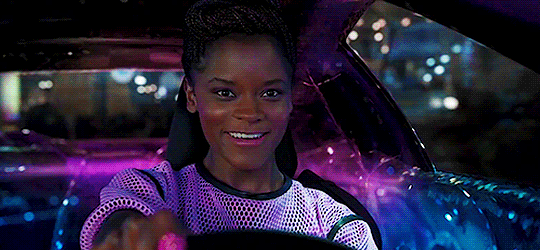
Yes, brilliant people can be unhappy and isolated by their intelligence, or rejected by society. But remember that intelligence isn’t synonymous with a cantankerous attitude, or an excuse to be a pugnacious ass to those around you!
Part of the reason why Shuri of 2018′s Black Panther was such a breath of fresh air was the fact that she subverted almost all preconceptions about how a genius looks, acts, and regards the world. And it’s not just the fact that she isn’t a sullen, middle-aged white man that makes her stand out: Shuri has an effervescent attitude, and genuinely loves contributing to her country and family. She referred to sound-proof boots as “sneakers” (and then explained the pun when her brother didn’t get it.) She’s fashionable. She teases her older brother, and cries when he is apparently killed. She’s up on meme culture. This makes her unlike pretty much every other genius portrayed in the MCU.
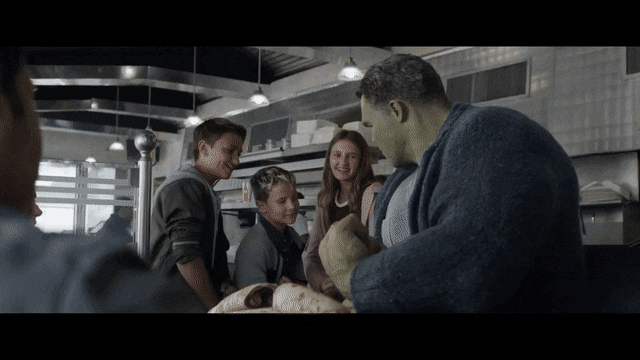
Except maybe the Hulk. He can dab now.
Shuri is also allowed to take pride in her genius, and can be a bit insufferable about it, which makes her more enjoyable and rounded. But she is an excellent example of how genius can be explored and portrayed in fiction, and I will forever be embittered that she was underutilized in Infinity War and Endgame.
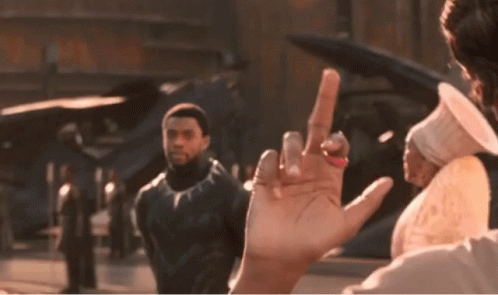
Why, for example, are all geniuses portrayed as arrogant misanthropes? Albert Einstein battled depression, but he is also said to have enjoyed blowing bubbles and watching puppet shows. He was kind to those who knew him. Similarly, Alan Turing behaved little like his fictional counterpart, described as “shy but outgoing,” with a love of being outdoors. Nikola Tesla fell in love with a pigeon. Why do we have to portray these people so damn gravely?
Other examples: Spencer Reid from Criminal Minds. Also an excellent portrayal of an intelligent person on the autism spectrum, as he struggles to interface socially but cares profusely for his fellow human beings. He is brilliant, and completely precious.
Also, Sherlock Holmes -- the original version, and all faithful adaptations thereof. Anyone who thinks Sherlock is an austere, antisocial jerk isn’t familiar with the original canon. He blushed when Watson complimented his intelligence, for God’s sake.
Then there’s Elle Woods from Legally Blonde and Marge from Fargo. Brilliant, upbeat, optimistic geniuses.
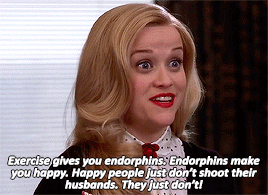
To apply this to your own writing: If you have a smart character who hates everyone around them for no identifiable reason, ask yourself why this is necessary and what this adds to the plot. Are they angry about injustice, towards themselves or others? Are they frustrated with an inability to relate to people? Do they want to protect themselves or their family at all costs, including politeness? If not, question why your brilliant character can’t also be kind to those around them.
4. Don’t make your character perfect at everything they do.
As demonstrated by: Wesley Crusher from Star Trek: The Next Generation.
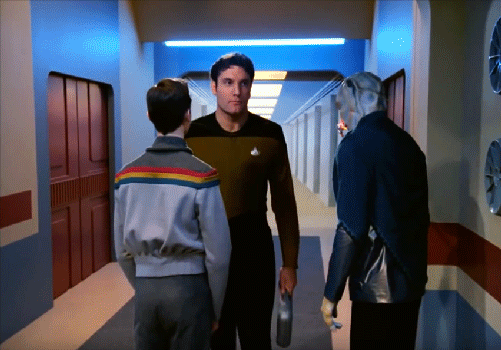
Ah, Wesley. Some call him the original Mary Sue, and it’s one of the only times I’ve seen the term applied with some accuracy. He is somehow the most gifted and least qualified person on The Enterprise. He’s Hermione Granger without the charm, jumping in to answer questions before any of the trained officers in the room have the chance to, always in the right. His only obstacle? Why, the boorish adults he’s surrounded with simply don’t understand his brilliance!
As early as the series’ very second episode, Wesley -- inebriated by an alien illness -- forcibly takes over the ship from Captain Picard, only to later save it from a threat with a reverse tractor beam of his own design.
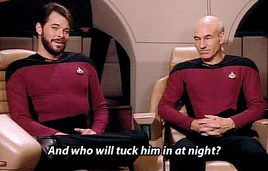
Wesley was obviously inserted as a means of attracting younger viewers, but failed egregiously, because he was too annoyingly perfect for kids to relate too, and not cool enough for them to be invested in. I binge-watched the various Star Trek series in my youth for Spock, Data, and my wife Seven of Nine, not to watch seasoned military and scientific officers get lectured by an adolescent. Even Wil Wheaton, who had the misfortune of portraying this character, expressed a dislike for him.
Precocious children are great, if you get them right. But get them wrong, and they can easily become your most annoying character, marring the face of otherwise great media. The most important thing you can do for a brilliant character is endow them with weaknesses and flaws -- even something as small as Shuri’s fondness for teasing her older brother made her enjoyable, as anyone with siblings could relate to their dynamic.
But, what if you want a supernaturally talented character who not only fails to be a ray of sunshine, but is something of an arrogant, antisocial jerk? Can they still work, especially if they also happen to be a child?
Yes, under one extremely important condition:
5. Do keep your characters out of their depth!
As demonstrated by: Number Five from Umbrella Academy.
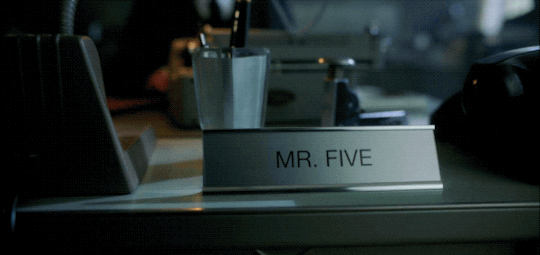
Okay, he’s not exactly a child. He’s a fifty-eight-year-old trapped in a child’s body, who’s traveled back in time from a post-apocalyptic future to warn his siblings of an incoming Armageddon. In other news, Umbrella Academy is a weird show. Unlike the comics, however, the apes don’t engage in prostitution.
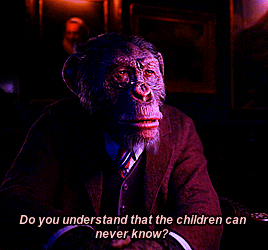
The effect, however, remains the same: a preternaturally talented child who talks down to everyone around him, including his (apparently) older siblings. So why does he work while Wesley fails so egregiously?
For one thing, it’s demonstrated early on that Five has the skills to back up his sanctimonious attitude, with the delightfully ultraviolent Istanbul (Not Constantinople) sequence. It also helps that he lacks Wesley’s squeaky-clean moral code, to the point at which he can get drunk in public or kill without remorse.
But: the element most vital to his success as a character is the fact that he’s kept completely, and consistently, out of his depth. He knows the world will end in eight days, but he doesn’t know how this will transpire or how to stop it. Ultimately, he fails again to stop the apocalypse, and must travel back in time with his siblings for another chance.
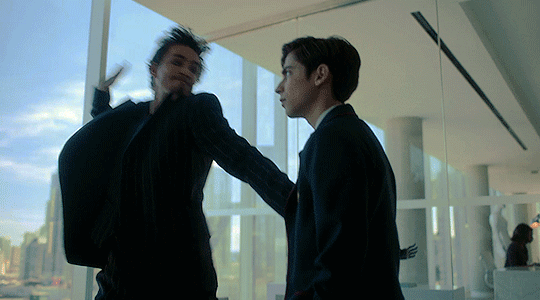
Most authors have the impulse to demonstrate a character’s brilliance by allowing them to succeed against insurmountable odds, but the Umbrella Academy writers show tremendous wisdom in allowing Five to fail. This allows the audience to empathize with him, and countermands the effects of his arrogant attitude.
This advice isn’t just true for pint-sized prodigies. Look back over this list, and take notes of how often the most successful characters are allowed to fail, to have flaws, and to ascend past their comfort zone.
Other examples: Virtually every successful example on this list.
Tommy Shelby, a character of limitless ambition, conducts a new, perilous climb outside of his social rank each season, which almost always puts him in positions of mortal danger. He faces threats both external (rival gangs, evil priests, and rising fascists) and internal (hello PTSD, suicidal tendencies, and crippling addiction) but either way, we understand that his fast-paced climb is not for the weak-willed or faint-hearted.
Mark Watney is a brilliant scientist who has been stranded in an utterly impossible situation for which absolutely no one could be adequately prepared (spoilers: it’s on Mars.) We are drawn in by his plight, and how he could possibly escape from it, and there we come to admire him for his courage, optimism, and humor.
Shuri, though not the main character of Black Panther, is allowed to show off both tremendous gifts and vulnerability, as she is powerless to stop the apparent death of her beloved older brother. She watches Wakanda’s takeover both as an innovator and a young woman, and a large reason for her success is that she is allowed to be both.
How to apply this to your writing: When portraying intelligent characters, take stock of how often they fail, their level of control over their surroundings, their vulnerability, and their flaws. We don’t want to read about flawless deities. We want to read about characters who embody and personify our humanity. So remember they need to fall down in order to pull themselves up.
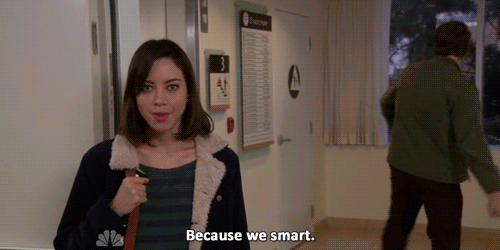
Happy writing, everybody!
#long post for ts#writing tips#writing smart characters#peaky blinders#tommy shelby#mark watney#the martian#miss fisher's murder mysteries#shuri#black panther#spencer reid#criminal minds#legally blonde#fargo#number five#the umbrella academy#star trek#star trek: the next generation
924 notes
·
View notes
Text
next round of in-progress naruto thoughts under the cut
[i actually haven’t progressed that far from where i was last time, honestly, but i could feel myself getting to a stage where i had some things i needed to write up.]
fyi, this one is a little more gripe-y than usual - still enjoying myself, but there are some things in the current arc that are bugging me.
[spoiler policy disclaimer first, as always: I am watching naruto for the first time and have only gotten to the point where naruto and bee break out of the island barrier and leave to join the war. i am trying to avoid spoilers, so please don’t interact with this (tags included, because the notifications now show them to me automatically) with any spoilery commentary, including even general things like “oh i love this show but it gets less good after X point” or “X season is better than Y season” or any general assessments of quality/likability/etc re: future seasons. Thank you! <3 ]
anyway, to go ahead with my grousing -
there are a couple things about this current arc that have me feeling "ehhh.”
1) too many dead people
i’ve personally always been lukewarm on the “revive/reanimate dead characters for the Confrontation Value” trope, which is probably due to me having been a comics fan for so long (i was pretty deep into DC-land during Blackest Night, and that’s not even the first/last time this sort of thing has been done there, so). i’m not saying it CAN’T be done in an interesting way, but most of the time my experience with it has been that it’s kind of cheap/redundant storytelling. it usually doesn’t add much to an emotional arc, for me, and when it retreads an emotional arc that did have a strong conclusion, i feel like all it does is weaken the original story.
so like - places where i feel like shippuden does this well are with minato and kushina. i found both of those scenes with naruto to be powerful moments that added something new to the story/to naruto’s development. (but they’re not even part of the whole reanimation jutsu plotline, which is what i’m mostly feeling “eh” on, so it’s not even the greatest example.)
a place where i’m kind of in the middle is with asuma. on the one hand, i really don’t think that this needed to happen, because the original story arc with him was SO strong. however, they did kind of redeem themselves in a way by focusing the redux on choji instead of shikamaru, so at least they were still saying/exploring something something new.
places where i’m still pretty dubious are pretty much...everyone else. i’m just not sure...well, i don’t know. i can’t really say definitively how i feel about it until i get to the end of the arc and see how it ends, but at the current moment, i’m just not sure what we get out of seeing people like zabuza+haku, lady chio, itachi, nagato, etc....ALL of those stories had such powerful endings; it just makes me leery of these “resurrections” invalidating everything we saw previously/weakening the impact of what came before.
2) mixed messaging
this is my bigger gripe, and it’s something i’ve kind of had floating on the edges of my mind for a long time, but this season especially is highlighting it.
the one thing that is guaranteed to make me frustrated about this show (besides its obvious disinterest in female characters) is when it starts to lean super hard into the “Naruto Is The Only One Who Can Do It!” for every single task that needs to be completed. and i know this is a stupid thing to complain about when the show is literally titled “Naruto,” but the reason it gets frustrating is because the initial message of this show was never “one super special person must do everything on their own and save everyone else.” the original message of this show was teamwork.
the very first lesson kakashi teaches the kids (and the foundation upon which the rest of the story has been built) is “you are stronger together.” if you had all come at me together, you might have been able to take [the bells]! he specifically criticizes naruto for working alone: “naruto - you do EVERYTHING on your own. EVERYTHING.” and that’s understood to be the Wrong Thing; it’s the reason naruto ends up tied to the stump. but in the last few seasons especially (though there have definitely been previous moments where this has shown up before) the ONLY thing we keep hearing is how naruto has to accomplish everything by himself.
it didn’t bother me in the Pain arc; i actually thought that confrontation was appropriate and necessary for naruto’s development. but ever since then, it’s escalated to a point where now it’s like - “naruto is the only one who can fight sasuke! naruto is the only one who can defeat madara! naruto is the only one who can stop the war! naruto is the only one who can erase everybody’s hatred!”
and that’s the point at which i start to get frustrated, because my mind is like “okay, and the other characters are going to be doing...what, exactly?”
again, maybe it’s stupid to complain about that when the show is literally titled “Naruto.” but i don’t think so. title notwithstanding, this story at its heart was, in the beginning, an ensemble show with four main characters, whereas nowadays, the messaging is that only one of those characters can actually accomplish anything. so i get kind of resentful, when i’m told that the other members of the team can’t do anything but step back and hold naruto up, because the essential message of this story has ALWAYS been “teamwork is more important than anything. you are NEVER stronger by yourself. we ALL have something to contribute.”
right now, the other characters feel like they’ve just been shunted off to do busywork. none of them have grown or changed at all since the end of season 10 (and even the end of season 10 was starting to slide into the “only naruto can do anything about sasuke in the end blah blah” - yes it’s a huge pet peeve of mine but it is what it is; whatever; moving on). we haven’t even SEEN sasuke since the end of season 10. there’s been no consideration given to how kakashi is handling being drafted into a second war and being put in charge of 20,000 lives (and his clash with zabuza was just a vehicle for all the characters to reflect once again on how great naruto is). there’s been virtually ZERO attention given to how sakura is handling things, minus that one scene where she’s looking at gory pictures from the previous great ninja war. everybody is just marking time, punching a bunch of identical white zetsus until naruto can come solve the problem and wow everyone with his new abilities.
part of my annoyance might just be due to the fact that the timeline is so wonky due to filler arcs - it feels like ages have passed for me, but in-universe it really hasn’t been all that long. but i also think there are legitimate reasons for me to be frustrated, when the show introduces things and then just unceremoniously drops them without any indicator of when they might be picked up again. like - the uchiha genocide reveal was (i thought) a Huge Fucking Deal that should have Major Repercussions - but it’s just kind of.....disappeared as an issue??? and yamato - he’s been CAPTURED!!!!!! but the show has not shown a single character reacting to this, or even being informed that it happened, and i think that’s shitty, actually. yamato isn’t a minor character. he’s been naruto’s personal guardian since season 2. he has done SO MUCH for the kids, and he is kakashi’s friend, and i think it is shitty to have him get captured by the same people who experimented on him as a child and then not spend a second or two making it clear that other characters CARE about this.
anyway. this is just something that’s been creeping up on me as time goes on, and the last few episodes of “Naruto is the Savior of the Entire World” talk just made it feel more immediate, i guess. plus the new intro (which i know may not be reliable; sometimes they show things that never happen) had a shot of naruto fighting itachi, and i think that tipped me over the edge, lmao, because you know what? enough!!!!! naruto can’t be the one who gets to do EVERYTHING! some stories are not about him! there are other characters who have relationships that are not about naruto. there are places where other characters should be able to accomplish things naruto can’t do. the other main characters should be allowed to complete their personal arcs, separate from (not just secondary to) naruto’s journey.
like - just - this is how i feel: this show started out as a story about a group of four people, and the root theme was “teamwork is everything.” i don’t like how the show has slowly started to mutate into a story about naruto’s “solitary” quest to save sasuke, when we have seen MANY TIMES that:
a) sakura was the first of the kids who even knew that something was wrong with sasuke, while naruto remained utterly oblivious all the way through shonen jump (and partway into shippuden, tbh)
b) kakashi in the past has connected with sasuke in ways that NEITHER of the two kids have been able to achieve
i just don’t like it. i don’t like how S10 had sakura say the line “naruto...you were the first one to ever see the darkness in sasuke...” when she’s reflecting on their fight on top of the hospital, because that is a LIE. it’s a blatant retcon. of the kids, sakura was the one who knew from the very beginning that something was wrong with sasuke. she was the one who was with him when he had that semi-dissociative episode during the bells test. she was the one who was with him during all the curse mark stuff in the forest of death. she was the one who knew something was off when he challenged naruto to a fight - naruto was just psyched that sasuke wanted to “spar” with him! and SHE was the one who suspected that sasuke might do something as drastic as leave the village - naruto explicitly told her not to worry; that sasuke was totally fine; he would never ever do something like that!
like - the show already barely gives sakura anything for herself; now they try to take this away from her, too? and give it to naruto? to hammer in a kind of connection between naruto and sasuke that demonstrably did not exist?? (i’m not saying that naruto and sasuke don’t have their own important relationship! but it is just provably untrue that naruto was the person who understood sasuke best. shonen jump goes out of its way to demonstrate how clueless naruto is about what sasuke is really like and what he’s going through. naruto is SHOCKED that sasuke would go to orochimaru. he doesn’t realize that their fight on top of the hospital is anything more than their usual rivalry business. when sasuke pops out of the coffin behind kimimaro, naruto waves and starts laughing, because he thinks sasuke is still on their side and is going to run right home! and even in shippuden, when naruto hears that orochimaru is dead, he gets all excited and goes “so sasuke must be on his way back to the leaf village!!! :D” like. he just doesn’t get it.)
and i won’t really get into kakashi’s side of things here, because i would end up writing too much, but suffice to say that i am just...wary of the way it feels like recent parts of the show are trying to minimize or...push aside the real, textually-documented connections that kakashi and sakura had with sasuke in favor of “Only Naruto Can Help!” it frustrates me. kakashi made inroads with sasuke that neither of the kids ever achieved. sasuke talks to kakashi in a more honest way than he ever does with either of his peers, even when he’s out of his head with rage. and i would prefer to see this show taking the angle that all three of sasuke’s team members are going to be indispensable for saving him.
you know. like teamwork.
#anyway#it's important to note that this is all preemptive grousing#it's based on how i'm feeling right now#but i still have so much to watch#the show could easily prove me wrong and handle things in a way that i feel better about#but i was feeling annoyed enough that i wanted to type this all up anyway#naruto#pan watches naruto
8 notes
·
View notes
Text
Assorted thoughts on “Little Women”
In no particular order.
*I’m glad I waited this long to read the original, unabridged novel. If I had read it as a teen or a preteen, I just might have followed countless girl readers’ example of having a crush on Laurie and being angry that Jo doesn’t marry him. Reading it now, I’m able to see him as the well-rounded, likable yet flawed character he is, not just as a girl’s prize, and realize that while he and Jo have a beautiful friendship, they wouldn’t have worked as a couple. The canon pairings of Jo/Friedrich and Amy/Laurie are the right ones.
*About the controversial issue of the characters’ ambitions... None of the young leads achieve their childhood dreams in the end; Alcott’s intended message was clearly “We don’t always achieve our dreams, but life can still be happy in ways we never expected.” That’s all well and good. But apart from Meg’s gender-neutral dream of being rich, the characters’ “castles in the air” are all in defiance of their expected gender roles: Jo wants to be a famous author and Amy a famous artist, two fields normally reserved for men, while Laurie wants to be a composer instead of going into his grandfather’s business. And all three of their endings are distinctly more gender-conforming: Jo becomes a schoolmistress, Amy becomes a society lady, both become wives and mothers, and Laurie goes into business “like a man.” I think it’s fair for modern readers to be disappointed by that conformity, even while appreciating the realistic message about childhood dreams. Those feelings aren’t mutually exclusive. For modern audiences, I think the standard adaptational change of Jo publishing her own version of Little Women at the end (instead of 20 years later in the last sequel) is a good change.
*About Jo needing to control her temper... I understand why this annoys some feminists. So often women are expected to suppress all anger and never stand up for themselves. Maybe it is problematic that role model Marmee explicitly never shows her anger, but only purses her lips and leaves the room. But personally, I think it’s presented in a healthy, gender-neutral way. Jo’s anger isn’t a problem because it’s “unseemly” or “unfeminine,” but because it can lead her to do cruel things to others. The mistake that teaches her the lesson in “Jo Meets Appolyon,” letting Amy skate on the thin ice, isn’t a loud, aggressive act of rage, but a cold, silent act (or rather inaction) of spite. Besides “control your temper” doesn’t mean “never stand up for yourself.” The book has several examples of women calmly yet firmly calling out other people’s bad behavior (most often Laurie’s ^–^) and it’s portrayed as entirely right. And though it’s tempting to be annoyed by Mr. March putting his finger to his lips when he sees his wife starting to get angry, it’s also a nice subversion of gender stereotypes to see a marriage where the husband is gentler by nature than his wife and is a calming influence on her. Stereotypical couples are the other way around.
*As a person on the autism spectrum, I relate strongly to Beth. I fully embrace the headcanon that Beth herself is autistic and that Lizzie Alcott might have been diagnosed as such if she had lived today. So it hurts a little to see other readers call Beth “boring,” “annoying,” a “doormat” and “the worst of the sisters.” Although she is idealized because she was Alcott’s tribute to her dead little sister, she’s not the cardboard cutout of bland feminine virtue she’s so often been stereotyped as being. It’s clear from the start that Beth isn’t “normal,” either by our standards or by past ones. Her crippling shyness isn’t just “sweet Victorian modesty,” but portrayed as a real flaw that she struggles to overcome. She’s been homeschooled because as a child her social anxiety made regular school unbearable for her. She still plays with dolls, believes in Santa Claus and has imaginary friends at age 13. She has no desire to get married, or to have any kind of career, or ever to leave her parents’ house. And because of all this, she clearly has a low opinion of herself: hence she tells Jo that she was never meant to live long, because she would never have been anything but “stupid little Beth, trotting about at home.” But the narrative belies her words. In both of her illnesses, so many people rally around her and reveal how much they love her and how valuable her quiet kindness has been in their lives. Ultimately she dies in peace because she realizes her life hasn’t been worthless after all. With my own social struggles, my tendency to be “younger than my years,” and my own desire to have a quiet life close to my family instead of going out into the big, overwhelming world and doing big, overwhelming things, I find her storyline beautiful, because it gives me hope that my life is just as valuable as anyone else’s.
*I also relate to Jo, as so many readers do. The result is that I’m of two minds of the chapters “Calls” and “Consequences.” On the one hand, there’s no doubt that Jo is at fault in those chapters and does more-or-less deserves to lose the trip to Europe. She’s genuinely, purposefully rude to her aunts and to the other people they visit and she humiliates Amy and harms her social life �� at the subsequent fair, the Chesters ban Amy from the art table because Jo insulted them. Plus the only reason why she has to join Amy in the calls in the first place is because she promised she would, so it’s hypocritical of her to whine about it. But on the other hand, I do empathize with Jo. With my own my social difficulties, I relate to her hating formal occasions where she has to dress up, mind her manners, make small talk about topics that don’t interest her with people she dislikes, and always be “agreeable” and “docile.” For Jo and for so many of us, it’s so hard to be that way, yet it’s the mold that all women were expected to stuff themselves into in the 19th century and to an extent still are today. Amy is lucky that she enjoys playing that social game and that it comes naturally to her. So it’s easy to sympathize with Jo’s envy when Amy is chosen to go to Europe, to feel as if Amy is rewarded for her social conformity while Jo is punished for failing to conform, and to feel as if the message is that all girls should conform like Amy. Fortunately, the book as a whole doesn’t send that message: even Amy achieves her ultimate happiness by letting herself be a bit more like Jo and call Laurie out on his laziness and apathy, when back in “Calls” she had argued that a lady should never show disapproval to a man.
*I don’t understand why some commentators think the chapter “On the Shelf” is so horribly sexist. Well, actually, I do. It’s tempting to find fault with John for being “jealous” that Meg is focusing more on their babies than on him and for “neglecting” Meg and spending carefree evenings out while she slaves away with the twins. And for Meg to be told by her mother that this is her own fault for “neglecting her duty to her husband” understandably rankles some feminists. But I honestly don’t think there’s any real problem. Meg genuinely neglects John and overtaxes herself by devoting every waking minute to the twins and letting neither John nor anyone else help her, because she’s afraid that otherwise she’ll be a bad mother. John isn’t jealous of the babies, he understandably feels ignored and useless. Nor (despite what some critics think) does he cheat on Meg, or want to. He just goes to a friend’s house rather than sit alone at home; Meg’s fear that his eye is roving to Mrs. Scott is just a product of her own stress. The resolution is arguably just the opposite of sexist: Meg finally lets John take an equal share of child-rearing duties, lets Hannah babysit often so they can both have time for themselves too, and steps out of her domestic sphere to share talks with John about politics, literature, etc. By the end of the chapter, their marriage is more egalitarian than ever.
*I’d like to read a fanfic where Jo meets Rodolfo from La Bohéme. I wouldn’t ship them, since they’re even more “too much alike” than Jo and Laurie are, but I’d like to see them meet. They’re both lively, passionate, temperamental ENFP writers, whose minds are full of “castles in the air” (they both use that exact phrase), yet whose lives both turn out differently than they had hoped, although Jo’s outcome is much happier. Both also adore a sweet, gentle, sickly young girl (Jo’s sister Beth/Rodolfo’s love interest Mimí) whose death they both regard as the end of their own youth. Furthermore, both of their authors modeled them after themselves. Jo is more down-to-earth than Rodolfo, though, and I’m not sure if they’d be friends or hate each other – Jo would definitely be indignant to learn how Rodolfo emotionally abused and broke up with Mimí because he couldn’t bear to watch her die, when she herself nursed Beth day and night through both of her illnesses and never left her side. But it would be an interesting meeting.
@fairychamber, @thatvermilionflycatcher
45 notes
·
View notes
Photo
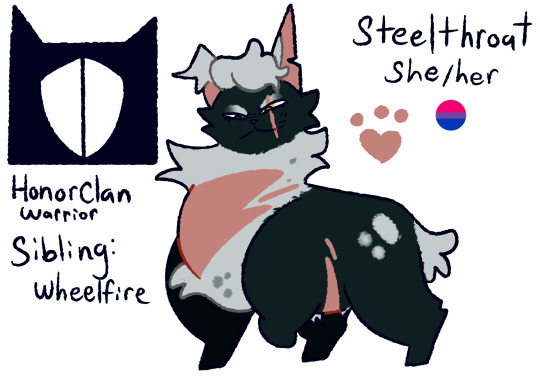


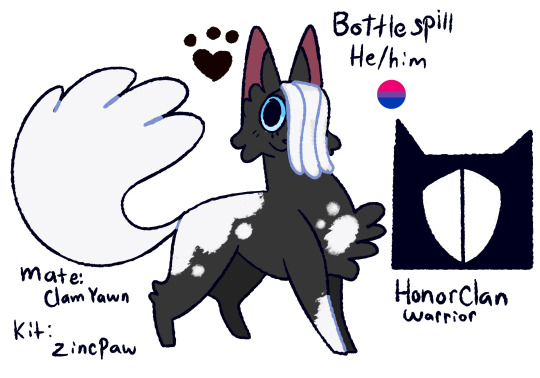
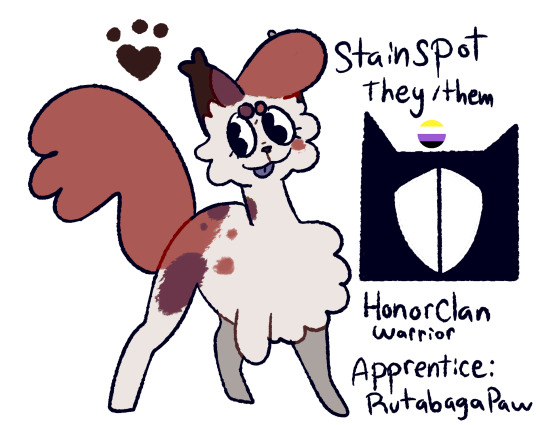


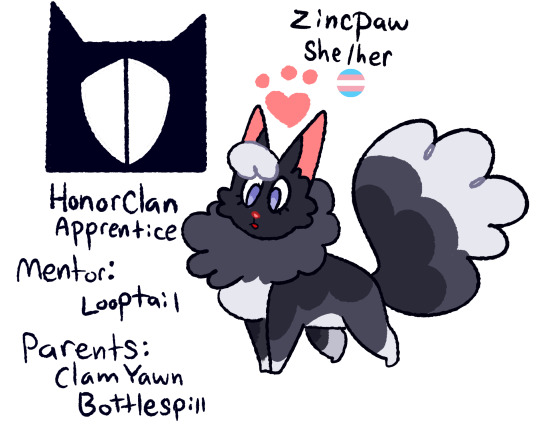
More Honorclan characters!
info and facts about them under the cut!
Steelthroat, once apart of a gang of ally cats who were known to be territorial and mean. After standing up to their leader Al she was attacked by him and had her throat terribly ripped. for most it woulda been their end. However for steelthroat it became her names story. she got back up and drove Al out.
she was named Steelthroat by the gang.
she is strong and tough, she knows she is hot shit and it shows.
she has had a few kits herself, some know her and either hate her for leaving their gang or will see her and quietly give her a nod. she also has some kids who have no idea she is even their mother as it just was how it was in the gang.
Steelthroats sister, Wheelfire previously named Wheels. while having a big giant gruff look to her is a big softy. she has wanted nothing more than to find a wife and have a family.
Wheelfire was the reason Steelthroat left the gang. she wanted her sister to have a comfortable life and to have a chance to life her dreams safely. Steelthroat would do anything for her sister.
Brickpelt is a tiny young warrior. they are snappy and often feel they should be in charge. Then often get left on patrol duty with apprentices. They feel they deserve to be deputy and are waiting to be noticed.
Bottlespill is a sweet and clumsy cat. He is liked by everyone but unwanted for patrols. often slipping off walls or missing prey.
none the less their mate Clamyawn adores them.
stainspot is another silly billy cat, they love to play around and can be flirty with others at times. their well rounded and likable and are a good scrounger and hunter.
Cluesplash is a big grump. He used to be a kittypet named Clue, had a house to himself. until his owner moved some other twolegs in and a basket of kittens. knowing Honorclan lived in the area, anything seemed better than a moment more in that house full of children. so he took off.
Little to Cluesplash’s knowledge he had been followed. Trailing behind was one of the kittens decker who took an instant shine to the unfriendly Cluesplash.
despite everyone thinking cluesplash is mean and even at times lazy Deckerpaw seems to see him as his hero. Deckerpaw looks up to Cluesplash and wants to show him that he can be great.
Cluesplash does not deserve Deckerpaws affection and often feels guilty for being mean to the kid and trys to be nicer to him.
Zincpaw is a curious girl who often gets herself into mischief, much to her mentor Looptails dismay who has a track record for raising good apprentices but is struggling to rain in Zincpaw. Zincpaw loves her life with her family but has found herself drawn to the marshes of Gloryclan
#warrior cats#warrior cat ocs#my ocs#steelthroat#wheelfire#brickpelt#bottlespill#stainspot#cluesplash#deckerpaw#zincpaw
378 notes
·
View notes
Text
LGBTQ Manga Review - Our Wonderful Days Vol. 1

After several weeks reviewing works containing whirlwind romances, ambitious science fiction, and bubbly fantasy, I was almost drowning in an ocean of sapphic plots. Kei Hamuro’s Our Wonderful Days is the perfect breath of fresh air to refresh me and allow for a brief respite before plunging back into the waters of angst, heartache, drama. I will admit, I was skeptical of Our Wonderful Days. When I first reported on it a few months ago, I expressed my doubts that it would sate the crazed beast in my heart, which feeds on quality expressions of romantic and sexual attraction between women. In a way, I was right, but I walked away from this manga with a different, gentler form of satisfaction.
Our Wonderful Days is a slice of life story, following a group of friends living their everyday lives. The story begins as protagonist Koharu Hanamura begins her first day of high school. She is excited to discover that her friends, Nanaya Asuka and Minori Kazami, are in the same class as her. Soon Koharu spots an unfamiliar but beautiful girl and is shocked to discover that it is her old childhood friend Mafuyu Shirotsuki, who moved away to Tokyo when they were young. From there, the series follows these four doing mundane activities, like checking out clubs or eating lunch. Occasionally the girls will split into pairs for a few chapters. One may follow Nanaya and Minori, who live together, as they do chores, and another sees Mafuyu and Koharu waiting for a train.

To say the plot is mundane would be an understatement. If I were not referencing the manga as I wrote this review, it would be impossible to recall the majority of the story I just described. Nothing happens in it; there are no stakes, no drama, it exists and continues. Interestingly, except for the volume’s final chapter, there does not appear to even be any build-up to a romance between the two girls, the archetypical Yuri plot. Slice of life series thrives on humor and charm. While Our Wonderful Days is by no means a comedy, there is an appeal to its accessible and aimless design.
There is something to be said in support of stories with a plot centered on nothingness (not in the philosophical sense). They are easy and relaxing. The reader is never forced to confront themselves or the conflicts of the characters but can find a moment of peace with the mundane yet enjoyable reading. I would almost describe Our Wonderful Days as gentle or tranquil, but I think “quiet” better describes the manga. The good kind of quiet, the variety encountered when one enters into their abandoned residence and throws themselves onto the couch after a stressful day and taking a moment of serenity before continuing to obey the summons of their stress or need for stimulation. As one can only enjoy such moments on occasion, I cannot definitively declare that I, a person who craves emotional investment and destruction in my fiction, am completely sold. But I was still able to appreciate the manga.

The personalities and traits of characters are often forged in the harsh fires of strife and conflict. Because of this, slice of life characters is often caricatures or tropes. There is usually the straight man, the zany-bouncy one, and maybe a tsundere. Our Wonderful Days thankfully exceeds expectations here. The characters are believable and realistic. While none of them are incredibly well defined, their interactions and dialogue make everyone feel more rounded and relatable. For example, Nanaya is easily excitable, does not contribute much around the house (and feels guilty for it), and is gay. Mafuyu feels distinctly different. She often makes direct and cutting observations, agrees with Koharu on all things, even to the point of self-contradiction, and is clearly gay. However, there were times when the good-natured ribbing felt more cruel than friendly, particularly from Mafuyu. My favorite character, however, is Minori, who is sweet, good at cooking, and obviously gay (get on that Nanaya).
The main objective of the art here was too not be too distracting from the mundane story and dialogue. It thankfully accomplishes this and more. The characters are distinct and well designed, with expressive faces, minimalist styling when appropriate, and different appearances. However, the characters all take second place to the backgrounds. These are detailed, often filling the pages, resulting in only a few occasions of floating characters. Hamuro also put the time and effort in to put varied background characters in, which makes the world feel full. The only complaint I can make is that in a few panels, while zoomed out, the characters’ heads appear oversized. Also, the first few colored pages in the volume show Nanaya with brown hair while she has green hair in the Japanese covers of volumes two and three. However, as the manga is in black and white, this makes absolutely no difference in anything, and no reasonable person would ever even mention it.

Our Wonderful Days is not a romance. But, there is a decent amount of Yuri content to be enjoyed. The relationships between the girls are front and center. Just observing the domestic life of Nanaya and Minori or seeing Mafuyu struggle to share her umbrella with Koharu is a unique form of service. There are hints at feeling stronger than that of friends, as Mafuyu is devoted and adoring of Koharu, a replicated feeling as it turns out. Also, Nanaya has a crush on the assistant coach of the basketball club and gets adorably flustered over it.

Our Wonderful Days is a soothing and simple manga. There are no risks or stakes involved, just a sweet and gentle feel-good series about girls being friends and living life together. The ambling and unfocused nature of the plot will likely bore some readers, but the characters are likable and the art fantastic. If you want a nice pleasant read to relax to, pick up a copy of Our Wonderful Days. If you would rather skip it, you will not miss much.
Ratings: Story – 6 Characters – 8 Art – 7 LGBTQ – 3 Sexual Content – 0 Final – 6
You can preorder the manga digitally and in print today: Our Wonderful Days Vol. 1 - https://amzn.to/2NyHZrw
Review copy provided by Seven Seas Entertainment ( @sevenseasentertainment )
#yuri#manga#reviews#lgbt#lgbtq#lgbtq+#queer#wlw#gay#lesbian#our wonderful days#seven seas#comic#anime#graphic novel#slice of life
266 notes
·
View notes
Text
Kanera/Kaesoka Prank War: Attack of the ‘Akul’!
Scene: Inside the Ghost. Kanan and Hera have a guest round to discuss a secret plan.
?????: You want me to do what?!?!?
Hera: It’s a simple as it sounds. Put the costume on, and terrorize that Togruta and her girlfriend.
?????: ... but if Tano thinks I’m an actual Akul I could get killed!!!!
Hera: Eh, I have faith in you being able to handle Ahsoka if the situation calls for it.
Kanan: I’ve got a bad feeling about this.
Hera: Shut up Kanan, no one cares what you think!
Kanan: :(
?????: Say I do this.... what are you willing to give me in return?
Hera: XD
One day later, at Kaesoka’s apartment. Kaeden and Ahsoka are relaxing on the couch together watching holovision.
Kaeden: Well... that was a terrible movie
Ahsoka: Certainly was. None of the main characters were likable. Is it wrong that I was rooting for the villain?
Kaeden: Usually I’d say yes, but in this case I’m with you. So... what do we do now?
Ahsoka: ... how about we...
Suddenly, a large orange beast smashes through the patio glass doors, making Ahsoka and Kaeden jump in surprise.
Kaeden: HOLY KRIFF!
Ahsoka: WHAT THE HELL?!
Akul: Raaagggghhhhhhhhhh!
Kaeden: 0_0
Ahsoka: OH CRAP! WHAT’S AN AKUL DOING HERE?!
Akul: Raaagggghhhhhhhhhh!
Ahsoka: Kaeden! Run!
Akul: Raaagggghhhhhhhhhh!
The Akul pounces across the room, tackling Kaeden to the ground, it’s mouth wide open and poised to bite her neck.
Kaeden: (Screams in terror) AHSOKA! HELP!
Ahsoka: KAEDEN! NOOOOOO!
Ahsoka uses the force to push the Akul off of Kaeden, before summoning her lightsabers to her, igniting the white blades in the process. By now the akul has regaining it’s footing and has spotted the lightsabers.
Akul: 0_0
Ahsoka: (Roars a battle cry and charges the akul, knocking it to the floor and sitting atop it, lightsabers ready to kill)
Akul: OK OK ENOUGH TANO, STOP PLEASE! IT’S JUST A DAMN JOKE!
Ahsoka: 0_0
Kaeden: 0_0
Akul: PLEASE DON’T KILL ME!
Ahsoka, confused, puts one lightsaber away and uses her now free hand to touch the akul’s face, discovering it to be part of a costume. Gripping hold of the mask, she removes it to reveal...
Ahsoka: MASANA? WHAT THE HELL ARE YOU DOING????
Ninth Sister: Heh heh... surprise I guess. Sorry about the glass.
Kaeden: What possessed you to do such a thing?! Ahsoka could have killed you.
Ninth Sister: What possessed me? Ten thousand credits from General Syndulla and her husband is what possessed me.
Kaeden: 0_0
Ahsoka: >:(
Ninth Sister: No can you please stop straddling my thighs Tano? Save it for your girlfriend!
25 notes
·
View notes
Text
Dunne Roaming (Griffin Dunne article from March 1988 issue of FILM REVIEW magazine) by David Aldridge
Film Review talks to Griffin Dunne, star of Who’s That Girl, After Hours, and Almost You, all available on video.
Griffin Dunne, the super-talented star of comedies After Hours and Madonna’s Who’s That Girl, has a new movie out on video. It’s called Almost You, and it’s on the CBS/Fox label.
Actually, it isn’t all that new. Dunne made the movie, in which he plays a seven-year-itch spouse wavering between wife and mistress, way back in 1984.
However, video’s product-voraciousness mean that all actors’ pasts have a nasty way of coming back to haunt them.
In fact, Dunne has fond, if vague, memories of the film. For starters, it was the start of friendships with cast and crew that would carry through into the subsequent After Hours, a dazzling Martin Scorsese comedy about the worst-imaginable night that’s also available on video, from Warner.
And, for seconds, Dunne amusedly [sic] remembers the way in which contemporary critics willfully confused character and actor.
“They never used the character’s name,” he tells me down the phone from a snowbound and freezing cold New York. “They would talk about Griffin Dunne being this spineless womanizer who does the dirty on his wife.
“They acted as if I was the one leading this immoral life. However, it was a fun film to make. I was really attracted by my character’s weakness.”
Almost You has been dubbed by CBS/Fox the first ‘yuppie’ comedy. Your reaction to that, Mr. Dunne? “None, really. I don’t know what it means. I hate the word ‘yuppie’.” Me, too!
But enough of Almost You. What all of you out there really want to know (isn’t it?) is what it was like working with Madonna on the much-pilloried Who’s That Girl, also now a Warner video.
“As far as I was concerned,” says Dunne, “she was first and foremost an actress. However, the fact that she was also a pop superstar did make working with her a rather different experience. It was the first and only time that I’ve worked on a set besieged by ‘paparazzi’ photographers.
“After about a week, I simply reduced my peripheral vision so that I simply didn’t notice them.”
It isn’t easy to draw Dunne on his view of the film - much vilified both Stateside and here. However, he does say both Who’s That Girl may not have been the best possible combination of constituents, and that often the movie business and the concept of fairness don’t meet.
“It’s impossible to tell why some movies lift off and others don’t,” he says. “Curiously, Who’s That Girl has become quite a cult film here since it came out on cassette.” The video isn’t doing too badly in the UK either, I tell him.
So far, Dunne, the son of movie-man turned writer Dominick Dunne, author of The Two Mrs Grenvilles, a society-murder story, recently filmed and now a CBS/Fox video too, is known almost exclusively for his comedic rules. [OP NOTE: Holy run-on sentence, Batman] His ambitions, though, lie somewhat broader.
“To begin with,” he says, “Almost You, After Hours and Who’s That Girl are very different sorts of comedies. You do them a disservice by using the same, single word to describe them.”
“Almost You is a bittersweet comedy whose central character is hardly likable in the conventional sense. After Hours is a romantic comedy. It’s the sort of comedy that Franz Kafka might have been written had he written comedy.
“And Who’s That Girl is the sort of screwball comedy that they made so well back in the Thirties. How people could call After Hours and Who’s That Girl similar films escape me. But they did.
“However, though comedy is where I seem to have made my mark so far, it’s not an area that I intend to confine myself to. I want to be a rounded, all-round actor, capable of turning my hand to anything.
“I’ve a few different projects in mind, but I’m loathe to talk about them yet. They’re still at an early development stage.”
It’s comedy, though, that will occupy the Dunne’s audience attention for the immediately foreseeable future. He’s just finished shooting the wacky Me and Him, in which an ambitious New York businessman suddenly starts getting vocal advice from a certain ‘cleverdick’ part of his anatomy.
Rumor had it at one time that Jack Nicholson would vocalize the one-eyed trouser snake. Not so, says Dunne. Stephen Marcus is the mooted voice furnisher.
Dunne wears two hats. One is an actor’s. The other is a producer’s. The latter is a legacy of cash-strapped early days when acting jobs were thin on the ground, and production seemed a somewhat more lucrative proposition.
Now, Dunne juggles the two, deriving equal but different pleasure from both. “Producing has always appealed to me,” he says. “More than acting at times. In fact, it was the first thing that I really got involved with when I gave up my early notions of being a writer or a journalist.”
[Final OP Note: Okay, what the hell happened behind-the-scenes of Me and Him? There’s gotta to be more to that production than I initially believed. First, you have a major cast of actors who were mostly established by the time this movie got off the ground. In the 1988 Interview magazine article, Dunne talks about animation sequences that aren’t in the final cut of the film. In that same interview, Dunne also talks about how he and the director, Doris Dorrie, disagreed on gender politics. Dorrie, in a Projection Booth podcast interview, talked about how Dunne was terrified this movie would ruin his career. Dunne, and I imagine the rest of its big-named cast, are reluctant to talk about the film to this day. He declined to do the Projection Booth podcast, and barely talked about it on Gilbert Gottfried’s podcast. Mark Linn-Baker from Perfect Strangers ended up voicing Griffin’s D, but the fact that Jack Friggin’ Nicholson was even rumored to be attached to this film? Based on circumstantial evidence, there must have been at least one script re-write, if not, several.]
3 notes
·
View notes
Note
atla for the ask meme, again! and some unpopular opinions thrown in maybe? mwah
my all-time ultimate fave character:
Prince Zuko. The angst, the drama, the stream of terrible choices, the hair (all four phases of it), and of course, the redemption. Zuko fucked me up as a kid. He set the bar so high for redemption arcs, and still to this day I’ve yet to see someone live up to it. STILL. Actually maybe Minya in Laini Taylor’s Strange the Dreamer, where the only truly evil characters are long-dead before the story starts. But Zuko really set the bar. He just tries SO hard, the way they handled his character was celestial.
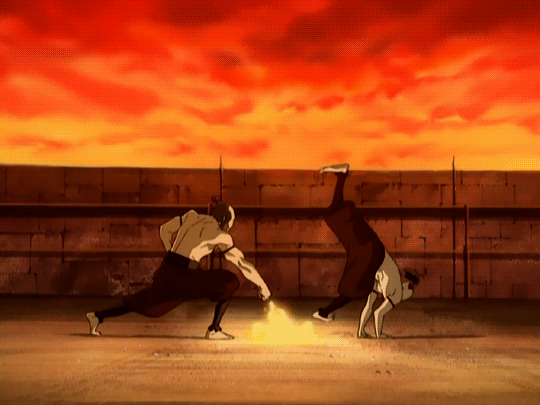
a character I didn’t used to like but now do:
Azula. Don’t drag me but obviously the first time I saw Azula, I was, what, 10? I actually think my timeline was off, in my Harry Potter post I said something about Book 2 coming out when I was 10 , I think I was 11. Anyway, the first time I saw Azula I was just like fuck she’s scary, and throughout book 2 she compounded this point by being fucking scary, so I didn’t like her because she’s The Bad Guy.
But then my brain grew in and now I’m like “she’s the most psychologically complex character I’ve ever seen in my life” and I literally love her. I could write an essay on how she’s not a sociopath at all, she’s got a Machiavellian type-A personality but she’s not a sociopath (which I think strips a lot of complexity from her character), she’s very much a product of her environment and it’s a fascinating examination of Nurture vs. Nature when you compare her and Zuko.
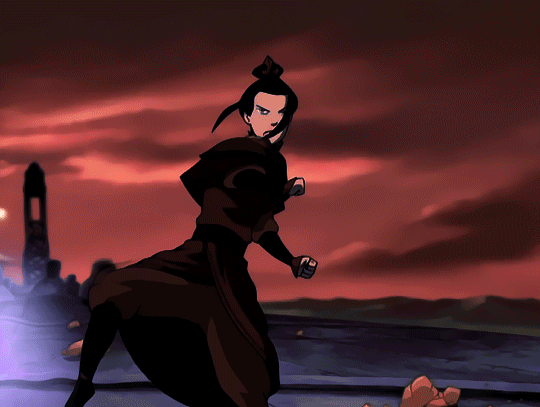
She turns defense into offense, look at that. She never loses ground in a fight.
a character I used to like but now don’t:
Hmm... I don’t think my opinion has changed on any of them tbh. They’re well-rounded, likable characters. Oh there’s one, Master Pakku! As a kid I was like oh he sucks cuz he’s sexist, then he trains Katara and I’m like ok he’s cool. But then?? I grew up and realized this man enforces this same societal bullshit, he just made an exception for Katara because he had a hard-on for her grandma so it’s some Snape bullshit lmao. So he’s the only I started to like and stopped liking.

a character I’m indifferent about:
Suki. She’s often depicted (in media and out) as a part of Team Avatar, despite appearing in only 4 episodes. FOUR. I really like her character, mostly because she’s a great example of a character playing important roles who doesn’t need a big character arc or development or even flaws. Think about it: Suki doesn’t have character flaws. She’s noble, honest but not naive, clever, a good leader, she doesn’t have flaws, she’s there to be there, and that’s perfectly fine. Wish I knew more about her tbh, like where is she by the timeline of Legend of Korra.
a character who deserved better:
Suki, lmao. Because she doesn’t appear a lot. And Ursa I guess, because I read Smoke & Fire and her arc with her daughter rejecting her face is so weird to meeeeee. It’s such a weird element.
a ship I’ve never been able to get into:
Zukaang. One’s a middle-schooler and the other is a high school junior, ew lmao. Zukka as well because idk, by the time these two interact without anyone else, other ships have cropped up and taken hold. Also Tyzula because Azula is cruel to her (but she’s also one of the few people she shows genuine affection toward without performing).
a ship I’ve never been able to get over:
None. I’m fine with most of the canon pairings but not head over heels. Maybe Sokka/Yue? That was sad.
a cute, low-key ship:
Zuko and his honor.

an unpopular ship but I still enjoyed it:
None tbh!
a ship that was totally wrong and never should have happened:
Ursa/Ozai lmao. Poor Ursa.
my favourite storyline/moment:
All of the tension from several gd episodes that led up to the Crystal Cave climax of Book 2. Runner up is Katara’s revenge arc. Bro... she stopped the rain. And I loved the look of awe on Zuko’s face like “thank GOD I switched sides.”
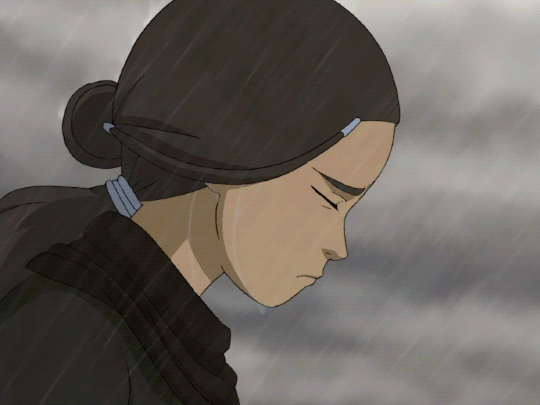
a storyline that never should have been written:
None?? ATLA is a near-perfect story. The ending is the most controversial part but I’m old enough now that I get it. I guess energy bending could’ve been hinted at way earlier, like maybe by the Guru guy, but I’m cool with the ending.
my first thoughts on the show:
Great show, love it, I wanna be an airbender, wtf was that ending.
my thoughts now:
Great show, love it, I wanna be an airbender, ohhhh of course the 12-year-old wasn’t going to murder a man on a children’s show lmao I get it now. And that’s that.

Ask me about a tv series/movie/franchise/book!
12 notes
·
View notes
Text
A Surprisingly Thoughtful Spin — Thoughts on: The Haunted Carousel (CAR)
Previous Metas: SCK/SCK2, STFD, MHM, TRT, FIN, SSH, DOG
Hello and welcome to a Nancy Drew meta series! 30 metas, 30 Nancy Drew Games that I’m comfortable with doing meta about. Hot takes, cold takes, and just Takes will abound, but one thing’s for sure: they’ll all be longer than I mean them to be.
Each meta will have different distinct sections: an Introduction, an exploration of the Title, an explanation of the Mystery, a run-through of the Suspects. Then, I’ll tackle some of my favorite and least favorite things about the game, and finish it off with ideas on how to improve it.
This game also has an additional section between “The Mystery” and “The Suspects” entitled “The Theme”, where I’ll talk about the philosophy within this game, and how it stands out and solidifies its place as a truly “Expanded” game due to that thoughtfulness.
If any game requires an extra section or two, they’ll be listed in the paragraph above, along with links to previous metas.
These metas are not spoiler free, though I’ll list any games/media that they might spoil here: CAR, brief mentions of CLK, CRY, HAU, and ASH, brief but slightly spoiler-y mention of the opening act of SPY.
The Intro:
The Haunted Carousel is, without preamble, a fantastic game.
I know I normally start these with a brief analysis of what stands out about the game or what it’s done for the series as a whole — and I will do that, never fear — but I think it’s important to establish first and foremost that, while it’s not an Overtly Beloved game, it very much should be, and it doesn’t get enough near enough credit. Especially since, in my opinion, the many great modern games’ tight plots and varied protagonists have their roots in this excellent game.
With a logical and ever-progressing plot, characters who feel like actual people, beautiful visuals, and historical backstories that round out the present day plots (plots!! In the plural!! Huzzah!!), Haunted Carousel may not be a wild ride, but it is a consistent, fun, and surprisingly thoughtful one.
CAR is perhaps the odd one out of its fellow Expanded games (SSH through SHA) in that its location isn’t really anything immersive. You don’t spend your time outdoors in thick atmosphere nor surrounded by trinkets of the Maya nor stuck on an old ranch, but between a bright hotel room and a shut-down (but not rundown) amusement park during the day. Its historical background isn’t linked to a specific area, there isn’t a “standout” scene featured in every gifset or trailer, and the wackiest the game really gets is expecting the player to enjoy Barnacle Blast.
In most ways, in other words, CAR is an exceptionally quiet game in the middle of quite a few loud ones, which might account for it not getting as much credit as it deserves. There are flashier games, there are longer games (CAR is quite short), and there are games with better and more memorable cutscenes…but there’s not many games in the series (and none of out the expanded games as well-told and sincere as CAR.
Not only is CAR a lot of fun to play, but it also takes care to mean something – to tell an actual story rather than a bare-bones whodunnit. The characters all have their reasons for being there and being involved, and they all have something to say as well — some directly contrasting each other. CAR doesn’t feel really like a computer game where everything is laid for the Convenience of the Plot and the suspects are only there to robotically deliver plot points and incriminate themselves. Rather, it feels like a whole story with real people where a crime happens to occur, but not everything revolves around that central plot point.
It’s also remarkable in the presence of a protagonist, which isn’t really something that Nancy Drew games have done yet. Nancy herself doesn’t count because at this point, Nancy doesn’t gain or lose anything from the mystery; she’s not the one with a problem, nor does she discover anything about herself. The Nik-era games are notable for their strong protagonists (or, often, dual protagonists with Nancy acting as one out of the two), but CAR really is the first one to take a character and have Nancy be a part of their story, rather than having Nancy act as a magnet to four pieces of metal and a mystery.
Mechanically, CAR is much the same as games that have come before it, as we won’t see another big upset until SHA, with the addition of Nancy’s cell phone (oh blessed day) and, most importantly, a task list. Fans had been asking for a task list since MHM (which sorely needed one so that you could at least identify which hanzi you had already seen) and CAR delivers that long-needed mechanical update.
The historical backstory is more recent than in most games, happening not in Antiquity or even during the 1700s but instead in the modern(ish) day, featuring the man behind the titular Carousel’s horses, Rolfe Kessler. The backstory doesn’t feel like an appendage like in DOG, but really establishes why the Carousel is so important and helps serve the theme of the game (more on that later).
The last thing that’s really important to note in CAR is its villain. By now, HER is reasonably okay at camouflaging its villain for at least the first third of the game, and here does a good job keeping the player in the dark for the first bit. CAR is also HER’s first successful attempt at the friendly villain archetype. Elliott Chen is pleasant, accommodating, friendly, funny, and incredibly likable. He just also happens to be a forger stretched thinner than he’s comfortable with.
Ultimately, The Haunted Carousel is a great game with a huge thematic presence, likable characters, and an honest character arc. Not only should it be a must-play for any new fan, it should be on the top of any older fan’s re-play list, both for its intrinsic value and for its obvious influence on the plots and protagonists of the modern Nancy Drew games.
The Title:
As far as titles go, The Haunted Carousel is a meh one – admittedly, it’s probably the weakest part of the entire game. It does tell us what our focal point will be — the Carousel — and the mystery surrounding the focal point – that it’s haunted — but, like DOG, it doesn’t really go much past that.
After completing the game, the title does mean a little more — the events of the game are a carousel of hauntings in that they seem to be cyclical and mysterious, but are really a farce — a simple fair ride with pretty decorations but simple parts. The carousel itself also points towards the villain, who’s the only artist out of the cast, and seems to allude to Joy’s cycle of sadness — she’s haunted as well.
It’s not a brilliant title, all things considered, but because the game is so good, it’s only a minor blip on the radar rather than something symptomatic of the game’s value.
The Mystery:
Paula Santos, a friend of Carson Drew’s, hears about Nancy’s penchant for solving mysteries and decides to call her in to investigate some thefts and sabotage that Captain’s Cove, an amusement park in New Jersey, has been encountering.
Nancy learns that first, the lead horse on the carousel was stolen, followed by the roller coaster losing power and causing a serious crash. The last straw for Paula was the merry-go-round turning on in the middle of the night, and Captain’s Cove has been shut down until someone — perhaps a badly-attired ginger fresh out of high school — can figure out what’s causing these problems.
It’s Nancy’s job to explore the shut-down amusement park, talk to the leftover staff, help reconstruct a carousel horse, and use such Astoundingly Modern Technologies as a cell phone and a laptop in order to crack the case behind The Haunted Carousel.
As a mystery, CAR is a pretty good one; it’s the age-old Nancy Drew Sabotage set up, but with the twist of happening at an amusement park. There are plenty of clues and even more red herrings, and the attempt to keep you guessing until the 3/4ths mark is a solid attempt.
I don’t know if this mystery feels more fun because it’s at a place like an amusement park or if really is that fun, but the overall effect is the same, and CAR is a delight to solve. The backstory and present story fit together like jigsaw pieces, and the suspects are both interesting and a ton of fun to question.
Is CAR an overly difficult or surprising mystery? Not to the modern mind, I would say, especially given the mystery fans’ inclination to suspect the friendliest suspect (a hole-in-one suspicion here). But it is incredibly fun to see how everything is put together, and it’s a water-tight mystery, if not air-tight.
It’s okay that the mystery isn’t the absolute greatest, however, because it isn’t the most profound part of the game.
The Theme:
Prior to CAR, Nancy Drew games didn’t really bother with the concept of theme. It was new and novel and difficult enough to design detective computer games that ran efficiently with decent graphics and to put them out twice a year that HER focused, quite rightly, on that rather than on trying more complex ideas.
With the formula and the game engine firmly established, however, and a small but fervent fanbase ready to devour the latest game — and being in charge of their own distribution — HER was ready to expand their games in a way separate from technology or location: it was ready for a strong theme.
As a character, Nancy deals with some pretty heavy stuff during the course of her mysteries. In the early games, we don’t really see it affecting her that much, which is a product of simple writing and, in my opinion, the child-like resilience of an 18 year old. While she has her occasional line like “to think I almost made friends with a jewel thief!” in TRT, these cases tend to engage Nancy on an intellectual level rather than an emotional one.
CAR shifts that narrative slightly and allows Nancy to bond with a suspect — Joy Trent — over their shared loss of a mother. Joy has also lost her father recently and is stuck in mourning over both her father and her childhood. Her father, having realized how both repressed and depressed Joy is, decided to build her a robot to help her get in touch with her childhood again. In other words, the jumping off point of the story is a father who wanted good things, happiness, and safety for his daughter, and tried to go about it in a way that he thought would be best.
If you’re hearing echoes of SPY here, you’re correct. The difference here being that Joy’s repression of tragedy leads her into a pit of inaction while stewing over that tragedy, while Nancy’s repression (which I’ll talk about more in my TMB meta) pushes her to action while ignoring the driving force of that tragedy.
CAR is also, I believe, the first time that Nancy mentions the death of her mother to a suspect, and it’s a really humanizing moment for her. As much as Nancy can be driven, tactless, and goal-oriented, she’s not a robot, and she does have personal as well as professional reasons behind the things she does and the characters she tends to bond with.
The first big thematic point in CAR is the importance of connection. It juxtaposes morose, prickly Joy (who doesn’t want a friend but gets one anyway) against our villain, who is friendly and smiling and charming but is by no means someone Nancy should make friends with. It also asks a question to tie into this theme: are those who are mean bad, and are those who are bad always mean? It’s almost a Shakespearean theme (“one may smile, and smile, and be a villain”) and it’s well-placed here.
The second theme comes up in the backstory about Rolfe Kessler, a genius who struggled all his life with mental illness, eventually ending with him never getting the credit he deserved and without the companionship of the woman he loved, Amelia.
It’s a tragic story in a way that HER hasn’t really done tragic stories yet — MHM has a basically happy ending, in TRT by the end the implication is that Marie is finally going to get the credit and un-blackening of her name that she deserves, FIN’s is a whole mess so we’re not even gonna try to dissect that, and in SSH the Whisperer is vindicated.
There’s no descendant of Rolfe in this game; no historian ready to exculpate him, no family members or friends to remember him fondly to Nancy over the phone. Rolfe is in the game, as in his life, alone. It’s a tragedy, and the way that Nancy and the player discover his genius and his story is quiet, as befitting the man.
Through Rolfe’s story we address the twin themes of remembrance — that how you’re remembered will generally be the way you lived (think DED’s dénouement for further insight) in the time that you lived — and of the role of trauma and struggle in life. Rolfe’s struggle against his illness didn’t make him a genius, but it did stand in his way of achieving all that he could.
And that’s where we tie into Joy and the main theme of the game. Once again, we see a person being limited by their mental illness and their struggle against it, and a world that doesn’t really take that struggle into effect. Instead of Joy being alone in this struggle, however, she has help — not just the small help from Nancy, but the help and support of her father through Miles the Magnificent Memory Machine.
Miles was created by Darryl Trent to help Joy unlock her childhood memories and move past her trauma in a healthy way – and only if she was actually dedicated to the task. The riddles, while not hugely difficult, are enough to dissuade Joy from ever really trying to get past them, as she’s not ready to open that lid just yet. As anyone who’s experienced mental illness (or had a close loved one experience it) knows, there’s no way for you to improve and grow if you’re not ready to receive the help you need.
Opening up just a little bit to Nancy and having someone who doesn’t have to care about her problems actually care is enough to springboard Joy to take the first step and try to tackle the riddles again with a little help. Over the course of the game, Joy gets more and more ready and less resentful towards her past and finds the strength to confront herself and her illness.
While the trauma of losing her mother in the way that she lost her (not to mention the added weight of her family’s financial situation) didn’t make Joy strong, the choice to struggle through and come out the better on the other side does make her end the game stronger than when she started and with more — pardon the pun — joy in her life. That progression is what makes her the protagonist, but is also sets her up to have the theme hand-delivered to her.
Miles states that it was Darryl’s belief that life is simply made up of memories. This is why it’s such a big deal that Joy’s memories of her mother are repressed, because her brain is actively erasing her life. As Joy moves through those memories with Nancy and Miles’ help, she gains back her life and is shown that, while struggle is a part of life, it doesn’t define life — and that a good life isn’t necessarily a life made up of only good things.
The presence of these themes (and of the final theme in particular) is what makes CAR such a strong game. Though the characters are delightful, the aesthetic is fabulous, the Hardy Boys are here, and the history and puzzles are fun, it’s CAR’s strong thematic elements interwoven with its plot that really makes it something special.
So let’s get on with those characters, shall we?
The Suspects:
Joy Trent is the current bookkeeper of Captain’s Cove and basically the man in charge apart from Paula. Her father Darryl used to work at/own half of Captain’s Cove, but died poor (specifically of a heart attack in bankruptcy court, poor man) after having to sell his part of the park to Paula. Thus, Joy holds a grudge against Paula even as she does good work for the park.
She’s also suffering a bit of childhood amnesia due to the trauma of her mother dying when she was young — the first of the women featured in this game series to share that backstory with Nancy. This forms a lot of the story’s B plot (with the historical backstory of the game being relegated to the C-plot) as Nancy and a funny little computer help her to move past this emotional block, confront her past, and progress to a better future.
As a suspect, Joy isn’t a bad pick at all, in part because she is responsible for a portion of the sabotage — the shut-down of the roller coaster while it was in operation – over bitterness for her father’s ignominious end. This little instance is helpful for diverting attention away from the true saboteur — though she doesn’t mean to — and it helps round out Joy as more than just the sad daddy’s girl (and resident protagonist) that she would be otherwise.
Well, other than her magical talking robot companion.
Miles the Magnificent Memory Machine isn’t really a culprit, but he definitely needs to be noted here, as he’s the best help that Nancy has outside of the Hardy Boys. Miles knows everything about Joy, yet he can’t move the story forward without Nancy completing a little task after task that unlocks the next portion of his (rather, by proxy, Joy’s father’s) quest to help Joy become a well-rounded, non-traumatized person who can face her past.
I’ve said enough about Miles’ part in the Theme section above, so I’ll move on without too much in this area.
Harlan Bishop is the security guard of Captain’s Cove and an ex-forger in a past life. He’s also voiced by Jonah Von Spreecken, best known for his long-running stint as Frank Hardy and for his writing of Francy fanfiction, God bless the man.
Harlan went to jail for forging checks and had a hard time getting a job once he was free, but Paula offered him a job as a security guard at Captain’s Cove and he’s been loyal since, even taking a pay cut in order to keep his job as the park was shut down. He’s also hilarious, giving such immortal quotes as “the whale is getting impatient” when trying to summon Nancy to the security office.
As a suspect, Harlan is interesting. He shares the key identity of the villain — a forger — as a red herring and as a way to complicate the mystery, and he does do something wrong in that he spies on Ingrid to get the passcode to her office. Sure, he does it for a good and innocent reason — he wants to be the best security guard he can possibly be, and that means learning everything about the park — but it’s still wrong to do, and Nancy (in a rather supercilious way) doesn’t hesitate to call him on it (and, once again rather arrogantly, for his past. Nancy’s done way worse than forgery in her hobby as a detective, after all).
Ultimately, Harlan is too good a guy to actually cause the problems and thefts at Captain’s Cove, and stays on with Paula even after getting other job offers once he helps Nancy recover the stolen lead horse for the carousel. He serves as Nancy’s “buddy” character after the mess with Nancy reporting him finishes its business.
Elliot Chen is the art director — and perpetually behind art director — of Captain’s Cove and our friendly neighborhood villain for the game. Elliott is the first to greet Nancy with a smile and a joke, and is friendly in a way that instantly suckers the player in.
HER has been trying since TRT’s Lisa to create a villain that’s actually a sort of friend to Nancy – or at least passes off as someone becoming her friend throughout the course of the game, and they nail it with Elliott. He even mentions Poppy Dada as a sort of inside joke with the player that makes one easily warm up to him.
As a suspect, Elliott is perfect. He’s sly enough to take advantage of what others do and fold it into his plan (the roller coaster) and to use people’s superstitions to his advantage both for privacy for his schemes and for driving the price of the carousel horses up.
He’s got just enough clues pointing towards everyone else — taking the eccentricities of his coworkers not only in stride but in good humor and flexibility towards his plans — and a pretty water-tight excuse for falling behind (procrastination — everyone knows artists and other creative types are the Worst Procrastinators) to help him pull off the vast majority of his plan without anyone being the wiser.
In short, Elliott is exactly the kind of character that this game needed, and his presence is a joy — even if (or perhaps especially because) he’s the villain.
Ingrid Corey is the chief engineer of Captain’s Cove, a graduate of OSU, and resident hippy-dippy “nutritionist” who can diagnose a B3 deficiency just by looking at Nancy. She’s a little crazy to talk to, but seems like at first she could just be using that to throw our resident teen detective off the trail.
As a suspect, Ingrid checks all the boxes once again, and not just because she, like everyone else, does something wrong. Ingrid, genius engineer that she is, decides to let a friend borrow the roller coaster’s blueprints to study them for a hefty fee, garnering her enough money for a 20K$ watch and enough left over to look for a new car.
Nancy also suspects her of insurance fraud with a man who got injured on the roller coaster when Joy sabotaged it, but it turns out in a show of startling naiveté, Ingrid just wanted to recommend a neck cream to the unfortunate man rather than help him profit off of his injury.
She doesn’t really become Nancy’s buddy, but she is remarkable in that she sort of disappears for most of the game. At the beginning, it makes her look a bit suspicious, but towards the end it just becomes clear that the game is less focused in Ingrid, who doesn’t really support the theme or move the plot along, and more worried about establishing its meaning and helping Nancy solve the case in time.
The Favorite:
While it should be obvious that my favorite part of this game is its theme and the associated thematic elements, I’ll try to branch out here a bit….though not so far out as to ignore the Hardy Boys, who are once again wonderful in this game. Honestly, most games with the Hardy Boys present are better than most games without the Hardy Boys. (Though of course, there are a few exceptions (notably ASH and SPY).)
CAR has one of my favorite casts (and favorite villains) of the entire series, so they’ll be here as well. It’s such a nice change of pace from games like FIN and DOG where the casts are lackluster to go to games like CAR that are so strong in making you care about the characters.
My single favorite thing about CAR, however, is the presence of a protagonist in Joy Trent. The first games (and quite a few of the middle games, it should be noted) treat Nancy as the main character and lack a protagonist completely, ignoring the fact that Nancy really can’t be a main character in the half-ghost (personality-wise) state she’s in, especially given that most of her dialogue is “ask a question, get an answer” rather than showing any real personality or particular motive beyond solving the case. Don’t get me wrong, I understand why that was the case given the limitations of the early 2000s and of HER in particular, but it does remove any possibility of Nancy being able to be the protagonist.
That’s why Joy’s presence is such a delight, honestly. She’s the character with the problem to solve — her past traumas — and the game carries Nancy through helping her in a way that Nancy’s never really helped anyone before. Sure, Nancy solves the mystery, but what she really does is offer peace to Joy, who can now grow up a little further and move on. CAR gives Nancy a purpose that will be improved and expanded upon in games like CLK, CRY, HAU, and GTH.
My favorite puzzle is the entire puzzle track with the carousel (including the conversation with Tink, who is a wonderful phone friend). There’s something super cool about going inside a carousel and finding out how the magic works, and there’s so much to explore in it that it’s really a magical place, even though it’s not actually anything supernatural.
My favorite moment in the game (other than the final ‘battle’) is the conversation with the Hardy Boys after Nancy nearly gets run over due to her own clumsiness. A classic.
The Un-Favorite:
Because of the care taken with CAR, there won’t be a lot in this section.
My least favorite puzzle is probably the mini-plot revolving around fixing Barnacle Blast — and then playing Barnacle Blast. While it’s not a horrible game in and of itself, it just doesn’t really fit the overall aesthetic of the puzzles of Captain’s Cove, and for me it sticks out quite a bit as a “oh we need a puzzle here what can we think of that the kids like” and came up with an arcade game in a vintage-style amusement park. It’s a bit off.
The stenography isn’t a great one as well, but I give it props for fitting the atmosphere and theme, so it’s not my least favorite.
My least favorite moment in the game…is probably where Nancy knocks over Elliott’s paint, as it seems to be a Big Moment but — Nancy doesn’t actually ruin anything, and it makes Elliott look a little silly.
I know that most of the games (especially as early as CAR) didn’t want to have Nancy do anything wrong in the non-second-chance story of the game, but actually having Elliot forgive her for messing up something important would have been a big step in establishing his character and throwing suspicion off of him — not to mention justifying his even further behind schedule as the game goes on.
The Fix:
So how would I fix CAR?
There’s not a lot of work to be done here, honestly. Take out Barnacle Blast and substitute it with a more on-theme mini-game, lengthen out the game a bit by playing up Ingrid’s plotline along with everyone else’s and perhaps giving Elliott something to do in the latter half of the game so it’s not so obvious by that point that he’s the Villain, and you’ve pretty much clinched it without any real re-working.
Like I said in the last paragraph of the above section, a tweak of the cutscene with “ruining” Elliott’s work would help his and Nancy’s storyline to have a different and improved feel, but that’s pretty much it as far as concrete changes go.
The beauty of CAR is that its simplicity actually works, rather than feeling bare-bones or underwritten. It’s not a difficult or complex mystery, but that’s not the point of Nancy’s being there or of the game as a thematic whole.
Sure, CAR deals with some pretty heavy themes such as loss, loyalty, debt, revenge, trauma, shades of mental illness, and even the question of is a bad person necessarily a mean person, but it accepts those bad things in stride and knows that they’re necessary in order to tell a tale of resilience and a happy ending. Miles the Magnificent Memory Machine delivers that theme to both Nancy and to the player, after all: “even bad memories have a place in a good life”.
26 notes
·
View notes